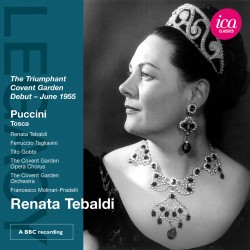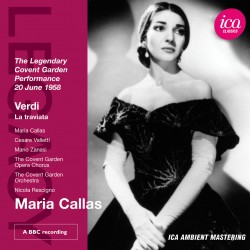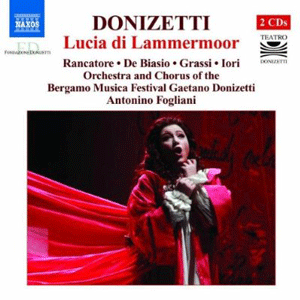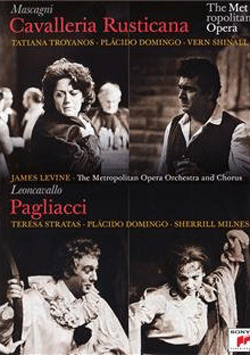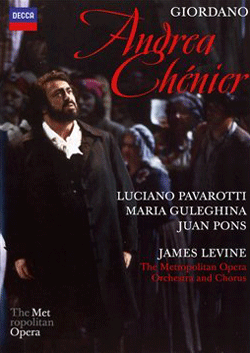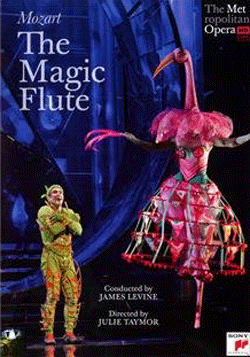March 31, 2012
Elmer Gantry the Opera
His best novels came relatively early, a string of successes climaxing with the Nobel Prize for literature — the first won by an American — after Dodsworth. He continued to produce novels until his death a couple decades later; they are mostly forgotten, and even his best work merits little discussion today. His themes of the banality and hypocrisy of American middle class mores haven’t exactly lost their relevance, but they seem obvious and forced. It’s interesting that, according to Richard Dyer’s excellent booklet essay, the inspiration for composer Robert Aldridge and librettist Herschel Garfein’s operatic adaptation of Elmer Gantry came while watching the 1960 film version. The cinematic version, with its Academy Award-winning performance in the lead by Burt Lancaster, at least retains Technicolor vividness.
The story of Elmer Gantry has a picaresque quality, as we follow a brash young athlete who, almost by accident, finds himself on the path to becoming a successful Evangelist, all the while pursuing his own need for female companionship and ego-building applause. The rather labored ironic ending finds Gantry leaving behind, if not in the dust then in the ashes of a fire, those who had helped him reach his goals, and moving onto to a vaguely “New Age” type religious re-birth. In another booklet essay, Leann Davis Alspaugh quotes the great line from H. L. Mencken that “deep within the heart of every evangelist lies the wreck of a car salesman.” Those relatively few pithy words put across the thrust of Elmer Gantry, at least as an opera. Over two hours of accomplished, professional composition and literary adaptation belabors the point at excessive length.
However, there is much to commend in the work of Aldridge and Garfein. In particular, Aldridge finds ways to use creative orchestration to give momentum and a sense of variety to a score that mostly builds upon the comparatively unsophisticated sounds of gospel music. There are hints of Copland from time to time, or perhaps one of Virgil Thompson’s documentary film scores. The problem is that when it comes time for an aria, that inspiring breath of original melodic inspiration that is found in the great operas of the standard repertory evades Aldridge. Nevertheless, when a booklet essay writer notes that the opera has already found a niche for itself at American music colleges as a fine piece to stage for aspiring singers, it’s clear that the sheer craftsmanship of Elmer Gantry the opera has earned it a kind of success.
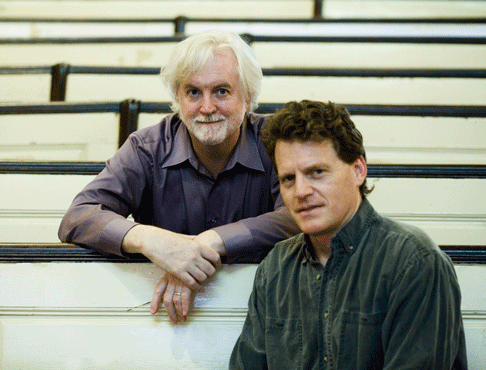 Composer Robert Aldridge and librettist Herschel Garfein [Photo by Jane Kung]
Composer Robert Aldridge and librettist Herschel Garfein [Photo by Jane Kung]
The Naxos recording, made before an enthusiastic live audience, benefits from the strong leadership of conductor William Boggs over the Milwaukee Symphony Orchestra and the Florentine Opera Chorus. In the title role, Keith Phares offers the kind of smooth baritone reminiscent of Nathan Gunn — a handsome sound without much character. In the somewhat superfluous role of Gantry’s best friend Frank, Vale Rideout strains a bit at the high end. Patricia Risley sings the lead female role of Sister Falconer, a female evangelist who is actually more interesting as a character than Gantry. Like Phares, Risley’s seems to have adopted a vocal production arguably closer to Broadway than to an opera stage, and a little more thrust and edge would have been good. In the role of a pathetic husband that Gantry cuckolds, Frank Kelley gets a manic mad scene that should go over very well for budding character tenors looking for competition pieces in English.
Naxos manages to provide a slim booklet with informative essays, production stills, and the libretto in English. On the debit side, Naxos doesn’t provide much tracking, with the long act one, for example, on CD 1 with only 6 tracks. Although your reviewer will reserve judgment on whether Elmer Gantry the opera belongs in a CD series called “American Opera Classics,” it is an honest and finely assembled piece that makes a strong case for itself. The same cannot necessarily be said for many American operas of the last decades with higher profiles.
Chris Mullins
[Editor’s Note: Elmer Gantry received two Grammy Awards for Best Contemporary Classical Composition and Best Engineered Album, Classical at the 54th Annual Grammy Awards (2011)]
image=http://www.operatoday.com/Elmer_Ganrty.gif image_description=Naxos 8.669032-33 product=yes product_title=Robert Livingston Aldridge: Elmer Gantry product_by=Gantry: Keith Phares; Sister Falconer: Patricia Risley; Frank: Vale Rideout; Eddie: Frank Kelley; Lulu: Heather Buck. Milwaukee Symphony Orchestra and Florentine Opera Chorus. Conductor: William Boggs. product_id=Naxos 8.669032-33 [2CDs] price=$15.99 product_url=http://www.arkivmusic.com/classical/album.jsp?ordertag=Comprecom172-587476&album_id=588343 Elmer Gantry Music: Robert Aldridge Libretto: Herschel Garfein Naxos CD 8.669032-33Gerald Barry: The Importance of Being Earnest
The decision to set a play as well-known as The Importance of Being Earnest cannot have been easy, surely, given the famous nature of the text. Was it intimidating? Or stimulating? ”It was hard and strange to begin and a joy after.When I began I wondered how to manage famous lines like “A man who marries without knowing Bunbury has a very tedious time of it.”I decided to treat them as Chorales sung by a choir, like in the St Matthew Passion, or like slogans held up by protestors. But having used the choir for about 90 seconds, I saw the text more clearly and dispensed with them. That’s why they only appear in Act 1 and never again.They are prerecorded and come across like messages from the Gods.”
I notice, in connection with this, that you famously set another famous text, The Bitter Tears of Petra von Kant, for English National Orchestra. “Yes it’s a wonderful text as well. It’s at Wilde’s level. It also is structurally sound and has a wonderful directness. No false note there.” The work (The Importance of Being Earnest) was written in 2009/10, I believe, and the Los Angeles performance was a great success. There is a delicious sense of humour running through your writing (the glissando-like up and down runs of the opening of act 3, for example), and a lightness of touch, both in the handling of the material itself as well as in the scoring. This is perhaps not associated too often with ‘modern’ music…I ask how Finnissy brought about the musical equivalent to Wilde’s absurdist text?. “Well, I’ve always loved Wilde’s ecstatic sense of nonsense — like Alice in Wonderland in a way. In Wilde there’s a dark uncaring humour, complete disregard for convention, delight in lying — and that’s my home.I don’t know if it’s an Irish thing or not — all I know is, it’s all I know.”
You have Thomas Adès conducting the Barbican performance (as he did, of course, the Los Angeles one). How does it feel to have another composer conducting your work? Is it true (in Adès’ case) that this brings extra insights (people frequently say that about Boulez, for example).
“When Tom is conducting I feel completely safe. In fact, when it’s a project initiated (I nearly said ignited — but it’s a good word) by him, it calls forth from me an extra energy. There’s a thing of entrails in operation when Tom is involved. He’s inspiring. He was born that way.”
There is a lyricism as well as bold humour here too in the music. As he re-read the play in preparation for the composition of this work, what were Barry’s reactions? What kind of processes did these reactions go through to find their way to the finished score?. “Well, various things presented themselves. For instance, both Lady Bracknell and Miss Prism are Germanophiles, so I made them composers. They both get to sing their own settings of Schiller’s Ode to Joy, and when Lady Bracknell gets carried away, she naturally breaks into German. By the third act, Lady Bracknell is more unhinged. She can focus, and ask questions, but if the answers are more than her brain can bear, she ignores them and goes on to something else.
“When Miss Prism is asked to identify the handbag, she goes into a withdrawn state of inspection, naturally humming the German national anthem as she does so, because Germany is crucial to her and Lady Bracknell.”
I comment that actors often say that comedy is one of the hardest parts of their art; would you say the same is true, musically, too? That, especially creating humour under a modernist aesthetic, is a challenge indeed? “It isn’t a challenge at all. I never think of being funny and never set out to be. I never think of aesthetics, or of anything at all. I just act. My body acts, my nervous system. Things just happen. When the audience laughed in LA I was startled to begin with — thrown. I know that sounds odd. I used to laugh alone at what I’d done. But it never occurred to me that my solitary laughter would become a public thing.
“In the scene in Act 2 between Cecily and Gwendolen, where they hurl insults at one another, 40 dinner plates are broken. I thought, apart from killing someone, what’s a good expression of anger?. And, of course, breaking things is one. So that’s how that came about. And because viciousness and fascism are one, I use hobnailed marching jack boots as well. And as I felt more was needed, I have the girls shoot one another at the end of the scene. Having done so they just go on to have afternoon tea, because they are as The Undead.” I comment that Barry is good at comedy, though: the LA Times blog (Culture Monster) called your second opera, The Triumph of Beauty and Deceit, written for Channel Four TV, “Non-stop nuttiness”…
“People who don’t know one another have said that kind of thing for decades so it must be true” comes the reply. Talking of which, I can’t help wondering about how US audiences coped with a dialogue about cucumber sandwiches…especially one set to angular dodecaphony…
“As far as I remember, even though I cut about two thirds of the play, I didn’t cut any reference to food and eating. And there are a lot of those in the original. So in my version they loom even larger. The men are as interested in food as they are in the women. There’s a strange moment when Cecily meets Algernon for the first time in Act 2, and out of the blue he says, “I am hungry”. The stage directions says “They pass into the house.” It’s eerie. You don’t quite know what might happen. I love the moment in Act 1 when Lady Bracknell says “I had some crumpets with Lady Harbury, who seems to be living entirely for pleasure now”, and the orchestra is suddenly hushed and dark. There is something unspeakable there.”
Regarding Barry’s musical language, I point out that although he uses twelve-tone techniques, this seems to be but one part of his armoury. There’s no mistaking the modernism of the keyboard opening — and how it incorporates Auld Lang Syne is delightful (as well as the comedy of the line “I don’t play accurately”...) The compositional challenge, it strikes me, is how to incorporate the variety of techniques you use into a coherent musico-dramatic whole. How did he craft this?
“I play that solo myself. It’s really hard and I don’t play it accurately! I was glad to be in one piece by the end. I was barely hanging on. I recorded it in one take the night before I went to LA for the premiere and got into a panic because I thought I wouldn’t make it because I hadn’t trained enough. I wasn’t fit at all. That solo was commissioned by my friend Betty Freeman before she died. I miss her and think of her a lot.
“I have a weird piano technique. I studied with an old lady in the west of Ireland, and then I met another old lady who was a pupil of Alfred Cortot’s so I received Cortot’s spirit from her hands! I use “Auld Lang Syne” like I might use a cup to drink out of. In the opera it’s an object surrounded by a whirling parallel world removed from it. They move together but have nothing to do with one another. The tune is the basis of the love duet between Jack and Gwendolen, and the duet between Jack and Algernon, and is usually used by the butlers Lane and Merriman to announce people. So it’s a structural pillar of a kind. About incorporating varieties of techniques or musics. These are really no more than a mirror to the circus of life. They work in the way we ourselves feel, see, hear, myriad things all the time which have no obvious connection. They are life.
“There are various kinds of musics used in Earnest — in that I think of musical history as mine, and roam in it where I will. But in the use of those musics there is an underlying reason each time. Instead of the so-called serial music after the beginning of the opera, I had originally written profound (of course!) music and when I put it together with the text, it sounded fake. And when I substituted the ‘fake’ serial music, it sounded funny and original. I think the reason is something like this: Wilde’s text is fantastically artificial, and when I went into overdrive to match it with similar originality, it was too heartfelt and became mawkish/sentimental. It betrayed Wilde’s text — making it ordinary. The tension disappeared. When I matched Wilde’s artificiality, with highly ‘contrived’ serialism, both were at home with one another, and there was no false note. One was as fake (artificial) as the other. They were happily surreal together.
“Maybe it’s that Wilde + Conventional Emotion is less good than Wilde + Artifice. And considering that there is so much deceit in the play, and his own life being filled with it, my fake serialism was truer to his world of fakery.”
I hear quite a lot of Straninskian sonorities and gestures in this work, too (the repeated note gesture heard at various points, including punctuating the patter-setting setting of the Ode to Joy, seems a case in point). Am I right in identifying this influence, and if so can you outline why he is important to you? Can you identify any other influences or references in your score? “You could be right in mentioning Stravinsky. I love him obviously. Who doesn’t?. But I don’t think about that when I’m writing. If by chance I regurgitated one of his atmospheres and did it honourably, I would be happy.” This is Barry’s fifth opera — and I assume not his last, given Earnest’s success. How does he see opera, as an art-form? An arena in which to explore a multitude of emotions (comedy, in this instance?). A still-vibrant art-form? “Opera is what it always was and will be. Nothing is ever in crisis. The only things that are ever in crisis are the people who use the forms. If there’s ever any weakness in anything, it’s the author’s fault. People who speak of the death of things talk rubbish. Everything remains the same. Everything is always the same. Nothing changes. All there are, are different levels of imagination, and that has always been the case. There is no advance imaginatively from Piero della Francesca to Wagner. They are both at the highest level and are therefore both the same. That’s all that matters. Any other considerations are footnotes.” I notice Barry created the libretto himself, taking Wilde as your starting point of course. But he had to make cuts, obviously — how hard was this, given the strength of Wilde’s play as an entity in itself? What did you cut, and why?
“I cut two thirds of the text. But I would say, that if you’d never read the play before, and read my remaining third, you wouldn’t know anything was missing. It shows how strong Wilde’s structure is. The play’s bones are unshatterable. My version is an X-ray of it.I enter into the play’s madness in varying degrees throughout. One of them is where Dr Chasuble says “Everything is quite ready for the christenings”. Instead of Wilde’s text in response to Chasuble, the whole cast respond with repeated vocal glissandi. They are like a menagerie, animals who cry out, beyond words.”
And finally, did Barry fashion any of the various vocal parts with specific singers in mind? “I did think of Barbara Hannigan — it’s rare that I don’t think of her!. Because she has a glorious high D, I gave her one as a present for her last note in the opera.”
For more details please see here.
The Birmingham premiere will take place on 28th April at the Symphony Hall, Birmingham.Colin Stuart Clarke
image=http://www.operatoday.com/Barry_Ades.gif image_description=Gerald Barry and Thomas Adès [Photo courtesy of Faith Wilson] product=yes product_title=Gerald Barry: The Importance of Being Earnest product_by=By Colin Stuart Clarke product_id=Above: Gerald Barry and Thomas Adès [Photo courtesy of Faith Wilson]March 28, 2012
Historical Performances from Covent Garden: Barbiere, La traviata and Tosca
ICA Classics appears to be a label dedicated to in-house tapes of live Covent Garden performances of the mid-to-late Fifties. Of the three sets reviewed here, all share constricted audio that mutes the orchestra but gives voices — at least the stronger ones — satisfactory prominence. Tape hiss, while audible, will not bother any but the most sensitive after a short period of adjustment. The question becomes then — how many “carats” can be ascribed for these nuggets from one of opera’s supposed Golden Ages?
The most fun comes with the 1960 Il Barbiere di Siviglia, with conductor Carlo Maria Giulini leading a tastefully raucous performance. The audience takes longer than the singers to warm up, by the time act one concludes, the stage action has broken through any stereotypical British reserve, and the extended bouts of laughter will make most any listener impatient to know what was happening on stage. Rolando Panerai sings a youthful, confident Figaro, but most of the laughter seems centered around the Bartolo of Fernando Corena. Luigi Alva offers a stylish Conte d’Almaviva, and for some of us, it’s nice to end this opera without the extended aria Rossini cut and later used in Cenerentola. Juan Diego Florez fires up standing ovations with this piece when he takes on the role, but it is narratively redundant and shifts the focus away from what should be an ensemble finale. Teresa Berganza made Rosina a specialty. There is much evidence here of the special quality she brought to the role — feminine and feisty — but either the stage action placed her further from the source microphone or the quality of her voice was not as susceptible to off-stage miking. Her vocal effect is dimmed by a recessed quality.
A couple of years before that 1960 performance Maria Callas made a notable appearance as Violetta in Verdi’s La Traviata. Although still in her mid-30s, 1958 finds Callas in variable voice. The middle still has warmth and agility, but the top is awkwardly approached and often unpleasant, although Callas holds onto high notes as if hoping the quality will improve through sheer determination. Act three comes off best, as she doesn’t have to extend upwards as much. Then again, it may have been an off-night for everyone. The stylish light tenor Cesare Valletti starts off “Un di felice” as if unsure of the key, and then seems to struggle with conductor Nicola Rescigno over tempo. He improves as the night progresses, but this is probably not a performance he would have wanted a permanent record of. Mario Zanasi is a competent Germont, not much more. This is a document for Callas-philes.
And for those still adhering to a supposed “Callas vs. Tebaldi” fan feud, the 1955 Tosca finds Tebaldi in glorious voice. Although the great soprano tends to let the sheer beauty and size of her voice carry much of the characterization, she does offer some moments of personal insight, including a spookily whispered repetition of “Mori!” at Scarpia’s death, and a sudden scream as her own final leap. For Cavaradossi Ferruccio Tagliavini pushes his voice forward, perhaps to match Tebaldi. While retaining his individual sound, Tagliavini stays at one emotional pitch, even in his act three showpiece. The biggest and saddest surprise is the Scarpia of Tito Gobbi. This is a role with which he will forever be identified, but as recorded here, he sounds dry all night, shouting for effect. One grows eager for Tosca to get her revenge. Conductor Franceso Molinari-Pradelli supports Puccini and the singers well, including a soprano “boy shepherd” in act three who sounds exactly like a mature soprano.
ICA Classics provides a brief booklet note that gives some basic details about the run of performances from which the recordings are drawn. Unsurprisingly, those commentators find each performance to be a long-lost gem. At budget price, there’s not much risk for the curious fan who would like to close his or her eyes, hop in an imaginary time machine and imagine themselves in London for these performances. Of the three, only the Barbiere gets a recommendation here.
Chris Mullins
image=http://www.operatoday.com/ICA_5046.PNG image_description=ICA Classics ICAC 5046 product=yes product_title=Gioachino Rossini: Il barbiere di Siviglia product_by=Figaro: Rolando Panerai; Rosina: Teresa Berganza; Count Almaviva: Luigi Alva; Dr Bartolo: Fernando Corena; Don Basilio: Ivo Vinco; Fiorello: Ronald Lewis; Berta: Josephine Veasey; Un Ufficiale: Robert Bowman. The Covent Garden Chorus (Chorus Master: Douglas Robinson). The Covent Garden Orchestra. Conductor: Carlo Maria Giulini. Royal Opera House, London, 21 May 1960. product_id=ICA Classics ICAC 5046 [2CDs] price=$22.99 product_url=http://www.arkivmusic.com/classical/album.jsp?album_id=654196
ENO announces Mini Operas: A Worldwide Online Talent Search to Inspire People to Create Opera
ENO Press Release [27 March 2012]
ENO announces Mini Operas, a world-wide, online search for composers, writers and film makers that will seek out emerging opera talent of the future from across the world. Three competitions to find future stars of all the components of creating an opera will be launched online allowing everyone to submit entries for one or more categories…
[Note: Follow the ENO Mini Operas program at http://twitter.com/#!/minioperas]
March 27, 2012
La forza del destino by Chelsea Opera Group
This fuels Chelsea Opera Group productions with the kind of commitment you get from true devotees who love what they’re doing. Founded by David Cairns, they produced Berlioz Les Troyens and even Benevenuto Cellini in the 1960’s, conducted by Colin Davis, closely associated with them since their inception. London would not be what it is without the Chelsea Opera Group ethos and its audiences.
Starting this year’s season at London’s South Bank, the Chelsea Opera Group presented Giuseppe Verdi’s La forza del destino, in the 1862 St Petersburg version rather than the more familiar 1869 Milan version. Chelsea Opera did La forza del destino previously in 1959, 1966 and 1986. Some patrons have heard them all. Last year, there was an excellent production in Paris, with Violeta Urmana, Marcelo Àlvarez and Kwangchul Youn. The Chelsea Opera budget can’t scale such stellar heights but compensates with verve. Gweneth-Ann Jeffers, Peter Auty and Brindley Sherratt gave performances so passionate that they filled the Queen Elizabeth Hall so effectively there was no need for staging. Jeffers and Auty sang these roles at Opera Holland Park in 2010.
In La forza del destino, Jeffers is a force of nature, expressing levels of Leonora’s personality hinted at in the score. Leonora is virginal but passionate. She’s planning to elope to South America, sacrificing her status for an outsider whose ancestors are descended from the god of the Sun (ie Incas). Leonora’s father is a bigot, and her brother equally rigid, but Leonora has greater depth of personality. Jeffers smoulders, caressing the low tessitura, soaring to crescendi and extended high passages. Forceful voice, well applied technique. Jeffers is a born diva, but her powers come from within, fuelled by intelligence and understanding of how music shapes role. Leonora is resourceful — who would chose to be a hermit in a monastery — but she can’t escape Fate. If Fate can destroy someone as strong as Jeffers’s Leonora, there’s no hope for anyone else. Verdi’s “Fate” motif flows throughout the music, sometimes seductive and subtle, but relentless. It surges in the big strings sections, weighted down by celli and basses. But when Jeffers sings Leonora the crucial aria “Pace, Pace”, she’s accompanied by harps, for she’s alone with God. Dramatic sopranos like Gweneth-Ann Jeffers are rare — why don’t we hear her more often in this country? She’s a resource we should appreciate.
Don Alvaro is a long and taxing part, but without staging, the voice is more exposed and has to carry the drama. Peter Auty was more impressive than he was two years ago. In this performance there’s an aria cut from later editions, which commands, as the notes say, “high tessitura and neurotic tension”. Auty threw himself into the spirit, singing with a heroism that captures Don Alvaro’s personality. No matter how hard Don Alvaro tries, Fate will destroy him. Dying early is no escape. Pehaps Don Alvaro will suffer more if he has to find redemption. Certainly, Verdi’s emphasis on spiritual rigour is blunted if Don Alvaro simply drops dead. The role isn’t meant to be easy, and Auty understood the poignancy, rewarded by audience applause. Auty’s young, by no means a bland “English tenor” and has a lot of potential.
The plot pivots around Leonora and Don Alvaro but Verdi expands the idea of Fate in many ways. Don Carlo (Robert Poulton) doesn’t think, or even feel much love for his sister. He’s programmed like an automaton, a manifestation of Fate as obsessive compulsive non-empathy. The part’s against Poulton, though he sings well. But Don Carlo is killed because he doesn’t even question things. Significantly, Verdi writes other characters to extend the concept of Fate. He didn’t write Preziosilla (Antonia Sotgiu) simply for colour. She’s not “gypsy slut” but represents something much more sinister. She is much more Mefistofele than Carmen, for she goads the soldiers on. “Rataplan, Rataplan” can be macabre, a Dance of Death, but here it was genteel, the COG Chorus and The Imperial Male Voice Choir singing with enthusiasm, taken in by Fate in the guise of provocateur.
Significantly, Verdi develops the monastic roles. The peasants suffer poverty and war, yet do nothing to change their fate. Fra Melitone (Donald Maxwell) has some insight, but rails at the peasants for being poor because they have too many children. (Celibates don’t understand). Melitone is also the gatekeeper and rule enforcer, a benign version of Don Carlo. Maxwell’s too nice to be nasty, but creates the comic aspects of the part very well. Il Padre Guardiano (Brindley Sherratt) on the other hand is a figure as powerful as Leonora herself, with dispassionate objectivity.
“Charity” he keeps telling Fra Melitone, meaning charitable feelings not free food. This kind of charity is exactly what Don Carlo and his father don’t understand. So they become tools of fate and die without having learned anything about life. Sherratt’s Guardiano is magnificent, utterly authoritative. Perhaps he realizes that Padre Guardiano is the voice of God, or at least, some superior, all-merciful being who might have to the power to thwart Fate. Notice how Verdi writes the part for the same voice type as the the Marchese di Calatrava (Richard Wiegold). The two men are polar opposites. Sherratt sings with such resonance that you sense the character’s emotional and spiritual depth. No wonder Leonora confides in him. Moreover, he breaks rules, letting her into the monastery. In the ending where Don Alvaro doesn’t die, Padre Guardino plays a pivotal role, implying that there are other values than revenge and pig headedness. Everyone dies in the end, but if you live properly, Fate doesn’t win. Leonora has learned this, which is why she finds a kind of apotheosis in death. God has shown her mercy.
Minor roles add spark to any opera, but much depends on who is singing them. I’m certainly looking forward to hearing Paul Curievici (Trabucco) again. He’s so involved with the opera that his face expresses what’s going on even when he’s just listening. Intuitive expressiveness like this is a gift that can’t be taught. This is the sign of someone who really act, from his soul outwards. He’s extremely young, so another talent to listen out for. I last heard him in the GSMD Poulenc Dialogues des Carmelites. In La forza del destino, he gets to sing a lot more, and does that well, too.
Robert Newton conducted the Chelsea Opera Orchestra and Deborah Miles-Johnson was chorus master. Three more Chelsea Opera Productions coming up this year — Donizetti Maria Padilla on 27 May, Massenet Don Quichotte on 25 November conducted by ROH chorus master, Renato Balsadonna. More details on the COG website.
Anne Ozorio
image=http://www.operatoday.com/Verdi_standing.gif image_description=Verdi standing product=yes product_title=Giuseppe Verdi: La Forza del Destino product_by=Il Marchese di Calatrava: Richard Wiegold; Donna Leonore di Vargas: Gweneth-Ann Jeffers; Curra: Patrizia Dina; Don Alvaro: Peter Auty; Un Alcade: Joihn Brice; Don Carlo di Vargas: Robert Poulton; Mastro Trabuco: Paul Curievici; Preziosilla: Antonia Sotgiu; Fra Melitone: Donald Maxwell; Il Padre Guardiano: Brindley Sherratt; The Doctor: Christopher Childs Santos. The Chelsea Opera Group Orchestra and Chorus. The Imperial Male Voice Chorus. Conductor: Robin Newton. Chorus master: Deborah Miles-Johnson. Queen Elizabeh Hall, South Bank, London, 25th March 2012. product_id=Above: Giuseppe VerdiMarch 24, 2012
Lucia and the glass harmonica
Unless…the conductor follows the fashion of adhering to the composer’s original thought and employing a glass harmonica in place of the flute. And that occurs more and more often. Two pieces of evidence here: a 2006 Bergamo Musica Festival production, and perhaps more surprisingly, the 2010 Mariinksy Theater recording. In both cases, the glass harmonica definitely adds to the creepy atmosphere of the scene. The Mariinsky recording offers a sharper aural picture, and the glass harmonicist etches a very clean line of echoing response to soprano Natalie Dessay. The glass harmonica counterpart in the Bergamo recording seems to be caught further from the microphones, slightly dulling the intended effect.
However, in most other respects the Bergamo version scores points over the Mariinsky. Some might have wondered if the starry names associated with the Mariinksy would mean a rival to the opera’s best recorded versions might be appearing. Such is not the case. Conductor Valery Gergiev has a broad symphonic repertoire, but his leadership of Italian opera has received mixed notices. Here, he sustains a poised reading, with no errant tempos or capricious highlighting of stray orchestral detail. Ultimately, however, the reading is a bit dull. More of that Gergiev idiosyncrasy might have helped. The supporting cast is mostly Russian (or at least house singers of the Mariinsky). The heavy tones of Vladislav Sulimsky’s Enrico and Ilya Bannik’s Raimondo blur the characters and veer toward cartoonish villainy.
Gergiev has two superstars as his leads. Lucia is a Natalie Dessay specialty, but this recording almost clinically details the wear and stresses on her instrument from her most recent vocal crisis. The voice is intact, but the suppleness is gone, and high notes fly uncomfortably close to screech territory. Surprisingly, Piotr Bezcala also seems to be in less than ideal voice, with his long final scene occasionally rushed and forced. Both have behind them many finer performances in these roles.
The recordings coming from the Mariinksy label benefit from handsome art design and traditionally generous booklets.
The Naxos, on the other hand, has a thin booklet and nothing else (this is the audio version of a performance also available from Naxos on DVD). The live production was nothing special to look at, and the audio version allows listeners to focus on what an idiomatic conductor and orchestra can provide, as well as the less starry but very capable cast.
Luca Grassi as Enrico and Enrico Giuseppe Iori as Raimondo both possess the right sound for their roles. As Edgardo, the Naxos offers Roberto De Blasio, a rising tenor who has started to pick up a few Metropolitan Opera assignments in the last season. He has just the right weight for the role - masculine, yet limber. In the years since this 2006 recording, he has hopefully brought some more distinctive coloring to his singing. In the title role, Désirée Rancatore puts on a high note display, with crisp coloratura. The middle voice, however, sags under a loose vibrato. Dessay may sound exhausted in her mad scene (not inappropriate), but Rancatore exhausts her listeners in hers, with more of an assault on the scene than an interpretation.
If neither of these versions comes anywhere close the best of the many available recordings of Lucia, the Naxos still deserves the edge for its fluency and old-fashioned commitment.
Chris Mullins
image=http://www.operatoday.com/MAR0512.gif image_description=Mariinsky MAR0512 [2CDs] product=yes product_title=Gaetano Donizetti: Lucia di Lammermoor product_by=Natalie Dessay: Lucia; Vladislav Sulimsky: Enrico; Piotr Beczala: Edgardo; Dmitry Voropaev: Arturo; Ilya Bannik: Raimondo; Sergei Skorokhodov: Normanno. Sascha Reckert, Glass Harmonica. Mariinsky Orchestra and Chorus. Valery Gergiev, conductor. Recorded in the Mariinsky Concert Hall, St Petersburg, 12-16 September 2010. product_id=Mariinsky MAR0512 [2CDs] price=$31.99 product_url=http://www.arkivmusic.com/classical/Drilldown?name_id1=3144&name_role1=1&comp_id=901&genre=33&bcorder=195&label_id=11847 Lucia di Lammermoor Music: Gaetano Donizetti Libretto: Salvatore Cammarano Mariinsky Theater - 2010 Orchestra and Chorus of the Mariinsky Theater Conductor: Valery Gergiev Lucia: Natalie Dessay Edgardo: Piotr Beczala Enrico: Vladislav Sulimsky Raimondo: Ilya Bannik Mariinsky CD MAR0512 Bergamo Musica Festival - 2006 Orchestra and Chorus of the Bergamo Musica festival Conductor: Antonino Fogliani Lucia: Désirée Rancatore Edgardo: Roberto De Biasio Enrico: Luca Grassi Raimondo: Enrico Giuseppe Iori Naxos CD 8.660255-56
Florian Boesch at Wigmore Hall
This was a wholly original, perceptive reading, informed by great insight. In Die schöne Müllerin the brook speaks through the piano. A brook flows forth with force. This isn’t a pretty little Bachlein, even if the protagonist is fooled. It powers a large commercial millwheel. This master miller employs many staff, and the brook keeps them all in work. The millwheel crushes grain into flour. The brook also controls the miller lad’s mind and crushes him with overwhelming force.
From the outset, it was clear that Malcolm Martineau understood why Schubert wrote such pounding, repetitive rhythms into the piano part. They are so shocking tthat most pianists soften them to make them more “musical”, but when they’re heard with this force, you realize that the brook is a personality. That’s certainly how the miller’s lad sees it. “Vom Wasser haben wir’s gelent, vom Wasser”. Right from the start, he’s doing what the brook tells him. The energy in the piano part is compulsive rather than merely compelling, so Martineau’s approach is psychologically right. The poem, too, reflects this hard-driven quality, with words repeated at the end of sentences, for emphasis. Boesch sings them purposefully, “Das Wandern”, ““Das Wasser” and “und wandern” yet again. Piano and voice in harmony, but it’s the unison of goosestep march.
Also perceptive was the way Boesch and Martineau revealed the jarring contrasts between each song. The hard-driven march gives way to more seductive rolling patterns, then voice and piano diverge. The miller has spotted the mill. Boesch’s voice warms with hope, “War es also gemeint?”, but Martneau’s dark pedaling tells us no. “Am Feierabend” is often sung gemütlich, for the miller’s lad now feels part of a community.. But the imagery includes the millwheel, still grinding when the workers are at rest. Martineau is ferocious, for the brook is, and will become ever more jealous. Later, the young miller will obey, but for the moment, he’s still contemplating love. Significantly, the voice is relatively unaccompanied at the start of “Der Neugierige”, and Boesch’s voice finds lyrical stillness. But the brook attacks again in “Ungeduld”, with its manic pace. Seldom have these mood swings seemed so bi-polar. In “Mein!” Boesch sings as if he’s won the girl. Martineau’s playing reminds us that the brook might think quite something else. Emphatic, brutal last note, no quibbling.
Many years ago, Matthias Goerne’s first recording of Die schöne Müllerin revealed the young miller as emotionally disturbed, living in schizoid fantasy. It’s a perfectly valid interpretation, though Goerne was to adopt a more conventional but superlative approach in his recording with Christoph Eschenbach. Boesch, however, makes the young miller sympathetic. Because it’s easier to identify with a miller created with such warmth, the brook’s vindictive pursuit seems all the more tragic. Boesch’s rich timbre and faint Austrian burr makes him plausibly masculine, so the rivalry between the miller and the huntsman isn’t entirely one-sided. No less than six songs in this 20 song cycle deal with the miller, the huntsman and the girl, with music and the colour green and all that signifies. The songs were performed without a break, since they’re a last interlude, when the miller still inhabits the real world.
With the minor key “Trockne Blumen”, the young miller enters the death zone. Boesch sings quietly but it’s an unnatural calm. His last cry “Der Mai ist kommen, der Winter is aus!” was a last backwards look at happier times. Martineau makes the last chords resonate into silence. The miller will not live to see Spring. The brook now “speaks” through the text, as well as through the piano. Miller and brook are becoming one again, the miller’s soul absorbed by the brook. This is surreal, even by the Gothic norms of Romantic poetry. Boesch makes interesting connections. His hands may clasp involuntarily, but the stillness of his singing suggests quasi-religious sacrifice. Did the poet Wilhelm Müller think of pre-Christian fertility rites, or to primeval myths of female water spirits luring men to their doom? It hardly matters. Boesch’s eerie calm is disconcerting. It’s as if the miller is willingly hypnotized.
The last song, “Das Baches Weigenlied” is a lullaby but most certainly not serene or comforting. Rolling rhythms again, but now the piano part falls into gentle repose. The brook is now speaking through the voice part and through the miller. It’s not the miller who is now at peace. He’s dead. The brook has consumed him and no longer needs to rage. Schubert sets the song lyrically, but it’s the culmination of a nightmare, straight out of the aesthetic that gave rise to Erlkönig (and indeed to Mary Shelley’s Frankenstein) As I’ve said many times before, only the shallow hear shallow in Schubert, but it needs to be said if we are to learn from him. This recital shows us what real Lieder singing is about. It’s uncompromising psychological truth.
Anne Ozorio
image=http://www.operatoday.com/BOESCH-2_credit_wiener-konz.gif image_description=Florian Boesch © Wiener Konzerthaus / Lukas Beck product=yes product_title=Franz Schubert: Die schöne Müllerin product_by=Florian Boesch, baritone; Malcom Martineau, piano. Wigmore Hall, London, 21 March 2012. product_id=Above: Florian Boesch © Wiener Konzerthaus / Lukas BeckRoyal Opera House 2012-13 season
Opera exercises many different feelings, Holten explained. As a young boy in Copenhagen, it opened out vast new horizons for him. Through opera, we engage with the drama of being human. Running an opera house is more than just business. Its “product” is creativity. If opera houses scale back and play safe, they lose the vision that makes opera thrilling in the first place. Holten’s strategy for straitened times is daring. Grow the audience from strength, giving patrons something to get excited about, whether they’re new to the genre or not.
Six new opera productions, higher profile revivals and an ambitious programme of external events that will expand the reach of the Royal Opera House far beyond Covent Garden. More live HD broadcasts, so ROH premieres can reach wider audiences. More links with smaller, independent companies. Even an experimental pricing structure. The whole atmosphere is a buzz, reflecting Holten’s dual responsibilities as manager and as creative artist.
Obviously the big Wagner Ring will dominate the autumn season. It’s sold out, despite sky-high prices, but Wagner’s anniversary is most definitely a special occasion. This production is aimed at a more general audience than a core of Wagner aficionados. Bryn Terfel, Susan Bullock and other stars ensure its success. This is a new Keith Warner production, conducted by Antonio Pappano. Wagner is always interesting and the sheer sense of occasion is part of the attraction. It takes the Met to really wreck the Ring. The ROH Ring should keep the house afloat for years.
In December, Giacomo Meyerbeer’s Robert Le Diable makes its first London appearance since around 1890. Once, Robert Le Diable was un succès fou, a sensation to which all Europe flocked, for it marked a new style in French opera. Heinrich Heine attended, incorporating it into his poetry “Es ist ein großes Zauberstück, Voll Teufelslust und Liebe”. Some of the arias are very well known, since Joan Sutherland was very fond of them. So hearing it in context is a great opportunity. There’s a renaissance in 19th century French opera, and the ROH has been on the crest, with Massenet, Berlioz and Gounod. The cast is superb. Brian Hymel who so impressed as the Prince in Rusalka, will be singing with Diana Damrau, Marina Poplavskaya, John Relyea and Jean-François Borras. This repertoire diverges from the Italianate style so fashionable at present, so it’s good news for opera adventurers exploring “new” perspectives.
Benjamin Britten’s centenary falls in November 2013, so the eyes of the world will be on how Britain honours the greatest opera composer it has produced. Britten often visited the ROH (he used to eat at Bertorelli’s) but he wasn’t really part of the ROH in-crowd then. So it’s good that the Royal Opera House is giving him his due, and with a twist Britten would have appreciated. Had the ROH been boring and played safe, we’d get another Peter Grimes. Instead, Holten has chosen the extremely rare Gloriana, which even Britten true believers don’t know well. This is thrilling, as Gloriana is problematic to stage, for Britten experiments with Elizabethan form. There’s only one recording (dull) but there is an Opus Arte DVD with Opera North (brilliant) that treats the work in cinematic style, which is an excellent solution (review here). It would be hard to top that, but the Royal Opera House has resources few other have, and Richard Jones as director could make it work. Strong British cast:: Susan Bullock, Kate Royal, Toby Spence, Mark Stone and other stalwarts, conducted by Paul Daniel. Definitely a “historic event”.
Three of the most important British composers are highlighted this year. Britten, Harrison Birtwistle and George Benjamin, “The 3 B’s” quips Holten. Perhaps the most significant British opera in recent years, Harrison Birtwistle’s The Minotaur, is revived at last in January. Get to this, since the DVD is inertly filmed, something I hope Holten will address at some stage, since film is the next frontier in bringing opera to audiences outside the house. Like any other part of staging it needs to be done well. John Tomlinson, Christine Rice, Andrew Watts and Johan Reuter return, and Alan Oke sings the part created by Philip Langridge.
George Benjamin’s first full scale opera, Written on the Skin, premieres March 8 2013. This is a very important occasion indeed, and will be heard in eight European cities. Benjamin’s not a fast writer, but painstakingly scrupulous, and this is his most ambitious large work to date. The libretto is by Martin Crimp, with whom Benjamin created the masterpiece Into the Little Hill. Read more about that here. The plot’s dramatic. A rich man hires an artist to illuminate a manuscript. The rich man kills the artist when the latter falls in love wuth the former’s wife and has him baked into a pie and served for dinner. Barbara Hannigan sings the wife, which means the part will be fiendishly inventive and demanding. That’s Hannigan’s specialty (read about her singing Boulez here on this site). Obviously a countertenor role to match, this time Bejun Mehta. Benjamin is a quintessentially European composer, so it’s good that Written on the Skin will be broadcast live, internationally in HD.
The Royal Opera House has always been good for Verdi. The new season brings a Verdi Immersion, three operas in succession, a sort of Verdi Ring, since his anniversary coincides with Wagner’s. The series starts, appropriately, with Nabucco, in a new production by Daniele Abbado and Alison Chitty. Plácido Domingo and Leo Nucci alternate Nabucco. Domingo’s presence alone will make this an attraction. He’s an icon as much as a singer. Acting isn’t affected by age. Domingo can project character, which is what this role needs. Since it’s Nabucco, the Royal Opera House chorus will be in their element. and they’re so good they could carry the show. Nabucco is followed by Don Carlos in May and Simon Boccanegra i in June/July. Although the latter are revivals, if they’re worth doing, they’re worth doing well, so the ROH is are injecting high-quality standards worthy of the best new productions. Antonio Pappano is taking over the conducting and Verdi is his specialty. Absolutely top quality singers — Harteros, Kaufmann, Kwiecień, Furlanetto, Halvarson, Hampson. Even if you’ve seen these umpteen times before, this time they will sound fresh.
It’s good that the Royal Opera House has in Holten a director who is a hands-on theatre person, because that ensures he’s on the ball as an artist. February brings his first ROH production, Tchaikovsky’s Eugene Onegin. Partly Russian cast with Simon Keenlyside for popular appeal. Robin Ticciati, the new incumbent at Glyndebourne, conducts. Since the ROH will be working more with other houses like the innovative Music Theatre Wales, what might this signify, if it means anything at all? Chances are that this time the audience won’t mindlessly applaud the scenery as they did at the recent ENO production, but instead pay attention to the music.
Also an indicator of new creative times is Gioachino Rossini La Donna del Lago in May, a new production directed by John Fulljames, Associate Director This is significant because it was to have been a co-production, but the Royal Opera House pulled out and created their own. This is radical, but it’s much better to do good work than regurgitate a turkey. Operas have a long run in time, so it’s a wonder this doesn’t happen more often and save more reputations, time and money. Holten describes Fulljames as the ROH “dramaturge”, an artistic philosopher with very strong theatre skills, as anyone familiar with his work over the years will recognize. Fulljames’s new production was put together efficiently, using pre-existing technical resources for new purposes. This isn’t recycling, but resourcefulness, as it takes a genuinely creative mind to work round difficulties. Much trickier than working from a blank canvas. Perhaps this is a good way forward at a time of budget restraint? The cast includes Joyce DiDonato, Juan Diego Flórez, specialists in this repertoire, so for singing alone, this new La Donna del Lago will be intriguing.
For more information please see the Royal Opera House website
Anne Ozorio
image=http://www.operatoday.com/Royal_Opera_House_with_ballerina.gif image_description=Royal Opera House and Ballerina [Source: Wikipedia] product=yes product_title=Royal Opera House 2012-13 season product_by=By Anne Ozorio product_id=Above: The Royal Opera House, Bow Street frontage, with the statue of Dame Ninette de Valois in the foreground [Source: Wikipedia]A Child of Our Time, Barbican Hall
At a little more than an hour long, Tippett’s 1939-41 oratorio might have been thought to make for short measure by itself, though I for one should much prefer to leave wanting more rather than to regret the inclusion of padding. In any case, the companion piece was certainly not padding on this occasion; we were treated to the London premiere of Hugh Wood’s delightful second violin concerto, written between 2002 and 2004, and reviewed in 2008 (premiered by Alexandra Wood, the Milton Keynes City Orchestra, and Sian Edwards in 2009). Cast in the ‘traditional’ three movements, ‘marked ‘Allegro appassionata e energico’, ‘Larghetto, calmo,’ and ‘Vivacissimo’, this proved to be a concerto worthy of any soloist’s — and orchestra’s — attention, and received committed performances from all concerned. Sir Andrew Davis is an old Wood hand, having recorded the composer’s Symphony and Scenes from Comus for NMC. His direction of the BBC Symphony Orchestra, also featured on that recording, seemed authoritative, rhythms tight and colours boldly portrayed. Likewise the contribution of Anthony Marwood impressed. His is not a ‘big’ violin tone, or at least it was not on this occasion, but his shaping of Wood’s lines and his irreproachable intonation — there are a lot of tricky yet always idiomatic double-stopping passages here — served the composer well. What struck me most forcefully about the work were the powerful echoes of Berg: to have as a kinsman, if not a model, the composer of the greatest of all twentieth-century violin concertos is not necessarily a bad thing. I assume that the harmonic relationship between the two works must be deliberate. Certainly the way Wood’s themes construct themselves — at least quasi-serially, by the sound of it — has strong parallels in the work of his august predecessor. Even the solo violin theme which enters in the second bar (a rising figure of semiquavers, G-B-E-flat-F-sharp-B-flat-D-F-A, which then continues to soar above the orchestra in lyrical crotchet triplets) seems to harness the spirit if not the letter of Berg’s example. The transformative technique to which the themes are subjected, and through which they are developed, may ultimately have its roots in Liszt, even Beethoven, but it sounds very much Wood’s own. I wondered also whether , especially in the rondo-like finale, there was something of a homage to Prokofiev, though this may have been nothing more than unwitting correspondence; whatever the truth of that, the woodblocks and other lively, rhythmic untuned percussion gave a hint of the Russian composer’s second concerto. (Wood in his programme note pointed to a ‘Spanish’ tinge, ‘prompted by Alexandra Wood’s playing of Sarasate).
A Child of Our Time had the second half to itself. Davis and the BBC SO again have a good track-record in the composer’s music, if not quite so extensive as the conductor’s namesake, Sir Colin. Marking both the increasingly traumatic turn of events in the 1930s — in particular, Kristallnacht and the 1938 assassination of a Nazi diplomat by a Jewish boy, composition beginning the day after war was declared — and the composer’s undertaking of Jungian analysis, this oratorio attempts to address the political by virtue of a turn to the psychoanalytical. That ultimately remains for me a problematical turn, though there can be no doubting the composer’s sincerity. Is it really enough in the Part Two scena — there are three parts, echoing Handel’s Messiah — for the Narrator’s ‘He shoots the official’ to be responded to with the mezzo’s ‘But he shoots only his dark brother’? It might well be the case that the fate of the boy whose tale is told obliquely can provide no answers, but do political atrocities really permit of a solution in which all we need to do is to master our dark unconscious?
At any rate, the oratorio received a fine performance. Its opening orchestral bars evoked a melancholy as ‘English’, if distinctively so, as the music of many of Tippett’s countrymen, up to and including Birtwistle, yet with its own harmonic and melodic inspiration. Are there in the music and the storytelling hints of Weill too, or does that merely reflect common influences? The BBC SO’s contribution impressed greatly, whether in the instrumental interludes — Tippett’s inspiration here Beethoven’s Missa Solemnis — or the more grandly orchestral passages, the opening to the Third Part rhythmically tight and implacable, not least thanks to Davis’s direction. The first interlude, with its trio of two solo flutes and solo viola against a softly singing cello section was powerfully matched by the third part ‘Preludium’, almost neo-Baroque, in which two flutes and solo oboe prepared us for the final peroration, chaste yet without Stravinskian coldness. Choral singing was excellent throughout, the BBC Symphony Chorus as ever well trained by Stephen Jackson, yet with an emotional as well as a musical weight necessary to convey Tippett’s pain and transformation. Strength in anger — ‘A Spiritual of Anger’ — was powerfully conveyed in ‘Go down Moses’, though the intonation of Matthew Rose’s bass contributions was not always spot on. Nicole Cabell and the chorus provided what is perhaps the most magical moment. An exquisitely floated and shaded — with fulsome, though never excessive vibrato — soprano solo, ‘How can I cherish my man in such days…?’ persisted whilst the chorus movingly ‘stole in’ beneath, with the spiritual ‘Steal away’. The use of five spirituals, clearly echoing Bach’s Passion chorales, seems to me not without its problems; simplification of harmonic language at times sounds a little abrupt. Yet again, compositional sincerity tends to win out over such doubts. Karen Cargill, whilst definitely a mezzo, brought a welcome hint of the traditional oratorio contralto too to numbers such as ‘Man has measured the heavens with a telescope’. I was less sure about John Mark Ainsley’s contributions, sometimes both lachrymose and underpowered, struggling to be heard above the orchestra. (It should however be noted that he was a late replacement for an indisposed Toby Spence.) This may be a problematic work, then, but it received for the most part powerful, enlightened advocacy.
Mark Berry
image=http://www.operatoday.com/Tippett.gif image_description=Sir Michael Tippett product=yes product_title=Hugh Wood: Violin Concerto no.2, op.50; Sir Michael Tippett: A Child of Our Time product_by=Anthony Marwood (violin); Nicole Cabell (soprano); Karen Cargill (mezzo-soprano); John Mark Ainsley (tenor); Matthew Rose (bass); BBC Symphony Chorus (chorus master: Stephen Jackson); BBC Symphony Orchestra/Sir Andrew Davis (conductor). Barbican Hall, London, Friday 23 March 2012. product_id=Above: Sir Michael TippettMarch 22, 2012
Albert Herring, LA
The British composer was born on November 22nd 1913 — St. Cecelia’s day, in the seaside town of Lowestoft. Before we go any further, I think you ought to know that Lowestoft’s chief export was herring.
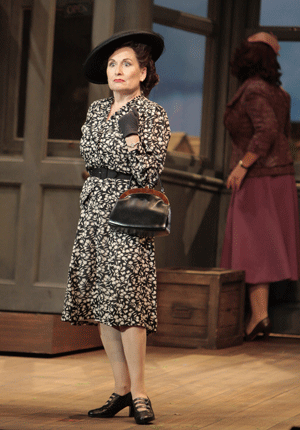 Janis Kelly as Lady Billows
Janis Kelly as Lady Billows
Though Britten is generally known to the operatic public for somber operatic works — the tragedies Peter Grimes and Billy Budd — he also had a lively, if far less frequently displayed musical sense of humor. In 1941,while living in the United States, he wrote the comical Paul Bunyon to a libretto by W.S. Auden. He returned to England in 1942, where Albert Herring premiered at Glyndebourne in 1947. Britten’s most concentrated piece of musical hilarity can be found in his 1960 A Midsummer Night’s Dream. Its Pyramus and Thisbe scene is a bright and brilliant take of 19th century Italian opera.
Albert Herring is based on a story called Le Rosier de Mme. Husson by French author Guy de Maupassant. The tale was suggested to Britten by librettist, Eric Crozier, then a member of Britten’s coterie. The story is set in Gisor, a French town in Normandy, socially structured much like towns of England’s Suffolk County, assuring that the transfer of locale was easily worked out. Its title can be loosely translated as Mme. Husson’s Rose King.
The essence of the French story’s plot and that of the opera are essentially the same. Both describe the eternal societal urge of small town’s upper crust to make its lower crust behave better. Though their endings and styles are far different — Crozier insisted the libretto have some kind of rhyming scheme — both plans for betterment go awry.
Lady Billows, the formidable doyenne of the fictitious British town of Loxford, is distressed by the number of illegitimate births, and decides to find, crown and reward a virtuous May Queen. When the girls suggested by the school teacher, the mayor, the police superintendent and the vicar are found wanting by Lady Billows’ equally formidable housekeeper, Florence Pike, the group decides to crown a May King. He is Albert Herring, a virginal boy who works in his widowed mother’s greengrocer’s shop. Poor, protesting Albert is decked out for the celebration in a white-as-a-swan suit and white hat decorated with orange blossoms. Sitting nearby, his mother glows with pride and waits impatiently to get the award money in her hands. But Albert’s friend Sid and Sid’s girl Nancy, hoping to loosen him up, spike his lemonade with rum. No sooner are the celebrations over when Albert disappears.
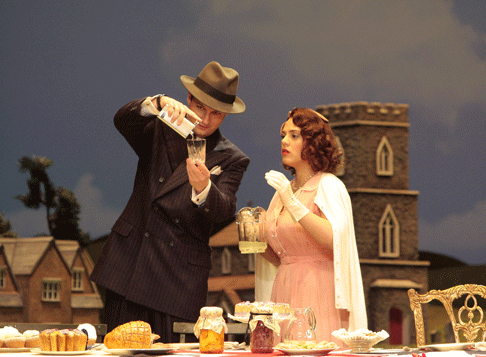 Liam Bonner as Sid; Daniela Mack as Nancy
Liam Bonner as Sid; Daniela Mack as Nancy
There is a huge search for the boy. A clue is found – a filthy orange blossom wreath. It is brought to the greengrocer’s home, laid to rest in the center of the table, and mourned by all in a masterful piece of music, an elegiac threnody, as if it were the boy himself. Albert’s sudden appearance in his sullied white suit seems almost unwelcome, but returns us to comedy as each person in turn interrogates him. His vice-laden adventures shock everyone but Sid and Nancy. And in conclusion, after everyone leaves, he tells his mother he’s keeping his money, and (horrors!) to mind her own business.
The Los Angeles Opera production, directed by Paul Curran was created for Santa Fe Opera, whose theater is open to the setting sun and other elements of nature. Differences in the set and lighting required for the enclosed Los Angeles theater, enhanced and intensified elements of the production. Subtle changes in the direction added to the comedy. Considering that Britten wrote the work as a chamber opera, it played well in the Dorothy Chandler Pavilion. Under James Conlon’s direction, the thirteen very individualistic characters on the stage, and the thirteen very precise musicians in the pit evoked the humor and pathos of Albert’s story. Maestro Conlon’s appreciation of the opera — he considers it one of the five great comic operas in the repertory — clarified elements of Britten’s scoring of the work; for example, the differences between the pompous music of the Lady Billows and town’s elite, and the rhythms of Albert and its shop keepers. Conlon also made sure, in word during his pre-performance talk, and in music when on the podium, that his audience heard Britten’s musical jest: the love potion theme from Tristan and Isolde as the rum was poured into Albert’s glass. Why not? This is the drink that will change his life forever.
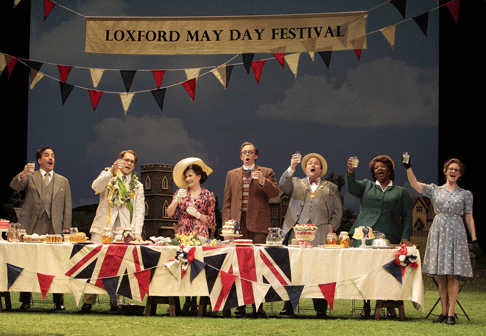 Richard Bernstein as Superintendent Budd; Alek Shrader as Albert Herring; Janis Kelly as Lady Billows; Jonathan Michie as Mr. Gedge, the Vicar; Robert McPherson as Mr. Upfold, the Mayor; Ronnita Nicole Miller as Florence Pike; Stacey Tappan as Miss Wordsworth
Richard Bernstein as Superintendent Budd; Alek Shrader as Albert Herring; Janis Kelly as Lady Billows; Jonathan Michie as Mr. Gedge, the Vicar; Robert McPherson as Mr. Upfold, the Mayor; Ronnita Nicole Miller as Florence Pike; Stacey Tappan as Miss Wordsworth
Every member of the cast with the exception of Stacey Tappan, Richard Bernstein and Caleb Glickman was making an LA opera debut in his production. Baritone Jonathan Michie, properly fussy as the Vicar, and lyric tenor Alek Shrader, charming as Albert, had appeared in their roles in Santa Fe. Shrader, who has been singing in Europe recently, will debut at the Met later this year. Janis Kelly’s interpretation of the officious Lady Billows left nothing to be desired vocally. She did however lack avoirdupois. One imagines her ladyship to be more generously proportioned. Christine Brewer, a more ample soprano and veteran of the Santa Fe production, sang the last two performances. Mezzo Ronnita Nicole Miller, a singer I have enjoyed in the past, played Florence Pike with great comic timing. Liam Bonner and Daniela Mack as Sid and Nancy, were charmingly carefree lovers, and Jane Bunnell struck the proper notes musically as well as theatrically, as the properly proud and distressed mother who knows a quid when she sees one.
Rarely does one wonder what will happen to the characters in an opera after the final curtain. Most often, all the ones we care about are dead. At the conclusion of Albert Herring, however, every Loxford resident we’ve met will go on living. One can’t help wondering about Albert’s future in the town. Mme Husson’s May King became the sobriquet for the Gisor’s town drunk.
Estelle Gilson
image=http://www.operatoday.com/alh2098.gif image_description=Alek Shrader as Albert Herring, with Daniela Mack as Nancy and Liam Bonner as Sid [Photo by Robert Millard for LA Opera] product=yes product_title=Benjamin Britten: Albert Herring product_by=Lady Billows: Janis Kelly/Christine Brewer; Florence Pike: Ronnita Nicole Miller; Miss Wordsworth, head teacher: Stacey Tappan; Mr. Gedge, the Vicar:Jonathan Michie; Mr. Upfold, the Mayor: Robert McPherson; Police Superintendent Budd: Richard Bernstein; Emmie, Village Child: Erin Sanzero; Cis, Village Child: Jamie-Rose Guarrine; Harry, Village Child: Caleb Glickman; Sid, a butcher’s assistant: Liam Bonner; Albert Herring: Alek Shrader; Nancy, from the Bakery: Daniela Mack; Mrs. Herring, Albert’s Mother: Jane Funnel. Conductor: James Conlon. Director: Paul Curran. Scenic and Costume Designer: Kevin Knight. Lighting Designer: Rick Fisher. product_id=Above: Alek Shrader as Albert Herring, with Daniela Mack as Nancy and Liam Bonner as SidPhotos by Robert Millard for LA Opera
March 19, 2012
Metropolitan Opera National Council Grand Finals Concert
There are a variety of organizations that use different methods to ensure that the next generation of singers is equipped with the experience they need to have a fruitful career in an extremely competitive environment.
Last year, for instance, Juliard’s opera department teamed up with the Met for their first annual co-production. In this case, Smetna’s The Bartered Bride allowed young singers to acquire stage experience as well as to work with big name officials such as James Levine. Other organizations such as Virginia’s Wolf Trap Opera Company dedicate themselves to cultivating new singers by designing entire seasons around them.
Still, the most popular method is the Evergreen Vocal Competition. The Met’s National Council Auditions are a fine example of such a vocal competition. Each March, less than ten finalists, selected from across America, are flown to New York for a concert, hosted by a famous singer and conducted by a well-known conductor. The concert also includes a surprise guest. The event, open to the public, is designed in such a way as to grant participants an invaluable experience while at the same time allowing the audience a sneak peek at upcoming talent. For the five chosen winners, the prize is $15,000 each and the opportunity to join in the Met’s Lindemann Young Artist Development Program.
This year, the Grand Finals Concert of the National Council Auditions took place on Sunday, March 18th. It was hosted by bass-baritone Eric Owens, who has been making waves in the role of Albrecht in the Met’s new Robert Lepage Ring cycle. Owens also fulfilled the role of guest artist. The five winners were baritone Anthony Clark Evans, tenor Matthew Grills, mezzo-soprano Margaret Mezzacappa, soprano Janai Brugger, and countertenor Andrey Nemzer. The Metropolitan Opera orchestra was led adroitly by Andrew Davis.
All the participants, regardless of whether they won or lost, should congratulate themselves on making the concert an extremely close competition. In past years, there were clearly defined winners and losers. This wasn’t the case this year. Anthony Clark Evans sang magnificently. Both his arias, “Si puo? Si puo?” from Pagliacci, and “Hai gia vinta la causa,” from Le Nozze di Figaro, proved that despite the lack of such baritones as Sherrill Milnes, true Italianate singing is thankfully not dead. Although, it must be said that his portrayal of the angry yet risible count in the latter case came up a little short.
Despite the extraneous vibrato in her rendition of “O ma lyre immortelle,” from Gounod’s Sappho, Margaret Mezzacappa was able to showcase her warm chest tones. Also, her rendition of “Hence, Iris, hence away!” from Handel’s Semele, showcased her adaptability with baroque ornamentation. Countertenor Andrey Nemzer showcased his ability as a fine-singing actor in Giulio Cesare’s “Domero la tua firezza,” while his interpretation of “Ratmir’s Aria,” from Glinka’s Ruslan and Lyudmila, was an utter joy to hear.
Soprano Janai Brugger, a crowd favorite, is clearly someone to watch. In both her arias, the famous “Depuis le jour,” from Louise, and Die Zauberflote’s “Ach, ich fuhl’s,” demonstrated warm tone and command of legato and ornamentation. The highlight of Matthew Grills’ two performances was the always-popular, “Ah! mes amis!” from La Fille Du Regiment. It was eye-opening; so many tenors go for the champagne aspect of the aria, a la Pavarotti, but his interpretation had a more day-dreamlike quality. His Tonio was definitely thrilled with his amorous success, but was lost in daydreams of love, as opposed to pouring forth ebullient expressions of joy.
The joy of this concert was that so many of those who didn’t win deserved compensations for their performances. Soprano Lauren Snouffer sang excellently in her second aria, “Air du Feu,” from Ravel’s L’Enfant et les Sortileges. However, I was very impressed with her ability to handle the seemingly endless recitative of “Padre, germani, addio!” from Mozart’s Idomeneo. Kevin Ray proved himself versatile, both as a Helden tenor in “Ein Schwert verhiess mir der Vater,” from Walküre, and as an Italianate singer in “Durch die Walder,” from Weber’s Der Freischutz.
Michael Sumuel was a superb actor in Leporello’s catalogue aria, yet he was also moving in Aleko’s cavatina from Rachmaninoff’s Aleko. Despite the concert’s short duration, Andrew Davis and the Metropolitan Opera Orchestra can congratulate themselves on splendidly navigating a wide range of repertoire that extended from Handel to John Adams, and along the way, incorporated seldom-performed composers such as Rachmaninoff and Weber. Eric Owens sang splendidly in King Philip’s showpiece, “Ella giammai m’amo,” from Verdi’s Don Carlo. His adept ability at phrasing was especially noteworthy during the repetitions of “Amore, per me non ha” (She never loved me).
Lastly, the audience was blessed with an appearance by Peter Gelb as Eric Owens was getting ready to sing. As he spoke, he reminded the audience that even if a certain singer didn’t win, it did not mean that they would not be seen again on the Metropolitan Opera stage. After all, it is important to keep in mind that such singers as Richard Tucker, Patricia Racette, and Joyce DiDonato did not win. Still, I am happy to say that all of them deserved to be there, regardless of whether or not they won. I look forward to seeing them all on the Met stage again.
Greg Moomjy
image=http://www.operatoday.com/2012Winners.gif image_description=Left to Right: 2012 National Council Audition Winners Andrey Nemzer, Margaret Mezzacappa, Janai Brugger, Matthew Grills, and Anthony Clark Evans. [Photo by Marty Sohl/Metropolitan Opera] product=yes product_title=Metropolitan Opera National Council Grand Finals Concert product_by=By Greg Moomjy product_id=Above: Left to Right: 2012 National Council Audition Winners Andrey Nemzer, Margaret Mezzacappa, Janai Brugger, Matthew Grills, and Anthony Clark Evans. [Photo by Marty Sohl/Metropolitan Opera]Levine conducts at the Metropolitan Opera: 1978 to 2006
Drama aplenty may occur within the Metropolitan’s offices or rehearsal rooms, but the only drama presented to the public stays within the confines of the stage action dictated by opera librettos. Appointed to the title of Music Director in 1976, Levine can look back on decades at the Metropolitan that stand as a singular achievement. That achievement will not be threatened by the sad turn that Levine’s ongoing health problems took last year, which forced him to withdraw from the rest of the current season and for all scheduled performances in the 2012-2013 season as well. For now, he retains the title of Music Director. The time is coming, however, when the Metropolitan Opera will have to transition to a new musical and artistic leader.
Whenever that may happen, Levine’s legacy will remain available for viewing, as not long into his tenure the Metropolitan began its famous “Live from Lincoln Center” telecasts, most of which are now available on DVD. And of course Peter Gelb, the current General Manager, initiated the Metropolitan Opera “HD Live” series of movie casts in 2006, with Levine conducting the premiere performance of an English adaptation of Mozart’s The Magic Flute. Viewing two of the late 1970’s telecasts (Verdi's Otello and the reliable Cav/Pag pairing), then a late 1990s’ performance of Andrea Chénier, and ending with that 2006 Magic Flute, one can see the effects of time on Levine’s physical self, but the aesthetic impression is of an ageless artistic entity, disciplined and steadfast in adherence to core musical values.
The Otello DVD alone could serve to establish the reasons for Levine’s artistic reputation. The orchestral performance powers ahead but retains tension in the quieter moments. Levine’s simultaneously manages to support the three leads, all great singers but none without flaws. The titanic Otello of Jon Vickers touches greatness, even though the tenor on that evening has occasional bouts with hoarseness. Cornell MacNeil, the Iago, finds a good match between the malevolent character and the less attractive — to avoid saying “ugly” — side of his vocal production. Renata Scotto is in fine voice as Desdemona, with only brief premonitions of the barbed-wire tightness that her top would exhibit too often thereafter. All flaws fall away in the performance’s best moments, including a devastating act four.
Considering his reputation today for tackiness and ostentation, some viewers may be surprised by the atmospheric, restrained settings director Franco Zefferelli provided. This is work that Zefferelli can be proud of - resolutely traditional but dynamic and dramatically concise. Those who followed the Metropolitan Opera in the late decades of the 20th century will be thrilled to hear Peter Allen announce the casts at the curtain calls after each act. Sony Music, which distributes these DVDs (except for the Giordano, which comes from Decca) for the Metropolitan Opera, provides no special features and only rudimentary booklets.
Zefferelli also produced the pairing of Mascagni's Cavalleria Rusticana and Leoncavallo's Pagliacci, also recorded in 1978. Almost as restrained in effect as the Otello, these operas benefit from Zefferelli’s eye for settings that can serve the larger scenes but also focus in on smaller spaces for the more intimate moments. The Cav set has the town square one would expect, but the Pagliacci somewhat strangely seems to be set in some sort of desert. The arid landscape and looming sky of the backdrop bring a sense of a dark dream to the action. As transferred to DVD, both this performance and that of the Otello suffer from murky, dark visuals.
In Italian repertory, Levine’s impeccable control may strike some as fussiness, but both these scores benefit greatly from the attention to detail and apt tempo choices. Plácido Domingo takes both leads. Despite his handsome presence, he doesn’t project Turiddu’s hyper masculinity all that well nor Canio’s borderline psychosis. Domingo reaches a higher level in the confrontation with the fierce Santuzza of Tatiana Troyanos. The rest of the Cav cast works at a lower level, especially the generic Alfio of Vern Shinall and the cheesy Lola of Isola Jones (who does, one must admit, smashingly look the part).
In the Pag, Domingo works with the affecting Nedda of Teresa Stratas, who should have fought her director when he asked her to dance and sing for most of her solo scene, affecting her breath support. Sherill Milnes looms ominously as Tonio (and of course loses his final line to the tenor). The dull Silvio of Allan Monk does drain away some of the show’s impact.
Moving ahead almost two decades for the Andrea Chénier of Giordano, Levine in 1997 may physically show the effects of the advancing years, but his leadership of the orchestra in a score than can come across as overblown and even pedestrian in places retains the positive attributes of the earlier performances. Here he has Luciano Pavarotti as his tenor lead, beefing up his sound fairly successfully and caught in relatively good shape. The TV director’s close-ups do the tenor and his heavy make-up no favors. Maria Guleghina’s Maddalena won’t please those who love the great Italian sopranos who have taken on this role; Guleghina tends to let the sheer physical force of her voice do a lot of the work, and an aria like “La momma morta” could use more delicacy. Juan Pons does his expected good work as Carlo, and the opera still manages to build up a good head of steam for its roof-rattling closing duet.
The production of Nicolas Joël shows one of the Metropolitan’s early efforts to update its production style. Joël melds some traditional tableaus with prop abstractions, especially in the suitably ominous finale.
By 2006, the Metropolitan had started not only to invite some of Europe’s top directors but also to reach out to top directors of “straight” American theater. Julie Taymor’s The Magic Flute, featuring her trademark puppetry and clever stage effects, was such a hit that the Met commissioned an English adaptation to a slightly abridged score, as a “Magic Flute for families". It still runs almost two hours, but it’s a fast, fun time, and Levine conducts Mozart with a lovely blend of taste and energy. The cast looks great, but none of them - with one possible exception - really exhibits the sheer atavistic star power that the Metropolitan Opera audiences have come to expect. Matthew Polenzani is a pleasant but anodyne Tamino, and his Pamina, Ying Huang, lacks personality. Taymor gives the Queen of the Night a spectacular costume, which helps Erika Miklósa make more of an impression that she otherwise might. Nathan Gunn clowns it up as Papageno, but his effort shows. Only René Pape commands the screen, but his accented English seems to be slightly handicapping his usual power. The English translation, by J. D. McClatchy, will be most successful for those who like cutesy puns and comic anachronisms.
Fans of Levine will want all of these; for those who may respect him but don’t necessarily count themselves as collectors, the Otello would be the indispensable selection.
Chris Mullins
image=http://www.operatoday.com/Sony_Otello.gif image_description=Sony 791012 [DVD] product=yes product_title=Giuseppe Verdi: Otello product_by=Otello: Jon Vickers; Desdemona: Renata Scotto; Iago: Cornell MacNeil. Metropolitan Opera. Conductor: James Levine. product_id=Sony 791012 [DVD] price=$17.99 product_url=http://www.arkivmusic.com/classical/album.jsp?album_id=595627&album_group=2 Conductor: James Levine The Metropolitan Opera and Orchestra Otello Music: Giuseppe Verdi Libretto: Arrigo Boito Otello: Jon Vickers Desdemona: Renata Scotto Iago: Cornell MacNeil September 25, 1978 performance Sony Music DVD 88697 91012 9 Cavalleria Rusticana/Pagliacci Cavalleria Rusticana Music: Pietro Mascagni Libretto: G. Targioni-Tozzetti and G. Menasci Santuzza: Tatiana Troyanos Turiddu: Plácido Domingo Pagliacci Music and libretto: Ruggero Leoncavallo Tonio: Sherill Milnes Canio: Plácido Domingo Nedda: Teresa Stratas April 5, 1978 performance Sony Music DVD 88697 91008 9 Andrea Chénier Music: Umberto Giordano Libretto: Luigi Illica Gérard: Juan Pons Maddalena: Maria Guleghina Chénier: Luciano Pavarotti 1997 performance Decca DVD B0016111-09 The Magic Flute Music: Wolfgang Mozart Libretto: Emanuel Schikaneder English adaptation: J. D. McClatchy Tamino: Matthew Polenzani Papageno: Nathan Gunn Queen of the Night: Erika Miklósa Pamina: Ying Huang Sarastro: René Pape December 2006 performance Sony Music DVD 88697 91013 9
Don Pasquale, San Diego
So here it is once again at San Diego Opera in its “spaghetti western” guise — the David Gately production that the opera company premiered in 2002. Happily for the opera company’s patrons it signals the end of their mourning period for poor, demented Salome and for the unfortunate crew in Moby-Dick. There’s nothing but rollicking operatic fun ahead for them.
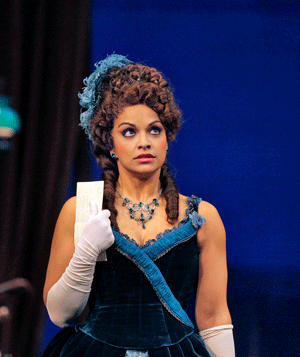 Danielle de Niese as Norina
Danielle de Niese as Norina
Not having previously seen this production, the Western “shtick” promotions for the work - ladies in corsets and cowboys in bubble baths — stirred old puritanical impulses and elicited my deepest fears. Of course transpositions of time and place are common in opera productions. In fact it happened to this very opera, Don Pasquale, just a few years after its 1843 premiere at the Italian Theater in Paris. Donizetti and his librettist Giovanni Ruffini had set the work in contemporary time. “But,” says the old Grove Dictionary of Music, “the singers and audiences considered there was a little absurdity in prima donna, baritone and basso wearing the dress of every day life; and it was usual for the sake of picturesqueness in costume to put back the time of the incidents to the 18th century.”
I needn’t have worried about sinful excess. As in that early Don Pasquale, picturesqueness in costume and sets is primarily what this clever production is about. Six-guns and horses notwithstanding, the most admirable element of Gately’s production is the restraint he showed in not allowing wild West gags and horseplay to overpower the essential commedia dell’ arte formula at the heart of this opera buffa.
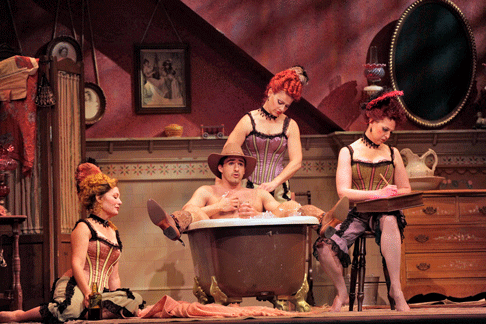 Charles Castronovo as Ernesto
Charles Castronovo as Ernesto
Don Pasquale was the last of the great opera buffas. At the heart of all of them were fairly formulaic commedia dell’arte plots, acted out by stock characters, behaving in satisfyingly predictable ways. There was usually a rich, old miser, a wily “dottore”, a shrewder-than-everyone servant. One or two of these had to be a bass or a baritone, who would likely sing a dizzying patter song. There were young lovers kept apart by some multifarious plot. She might be a soprano or a mezzo-soprano, but he most likely was a tenor. The plots were generally filled with intrigue involving love affairs, money, inheritances, mistaken identity and the like. It made no difference how complicated the machinations of the first two acts were. By the end of the third act everything will have worked out perfectly and audience and characters went home happy.
In Don Pasquale, miserly rich old Pasquale plans to marry Norina, a young and beautiful woman, who loves a young and penniless man, Ernesto, Pasquale’s nephew. Norina and Ernesto scheme with a wily dottore, Dr. Malatesta, to outwit Pasquale. Pasquale schemes with the same wily Dr. Malatesta to outwit Norina and Ernesto. Confusion. Who’s doing what with whom and where? But fear not! Don Pasquale is fooled into letting Norina go. Norina ends up with the Ernesto. Ernesto ends up with both Norina and Don Pasquale’s money. What could be better? The great music with it. Donizetti had an enormous gift for melody from the coloratura of emotional highs to lyrical, love-lorn laments. And better still, he wrote humor into his music - rollicking, rhythmic, playful music that can get you bouncing in your seat.
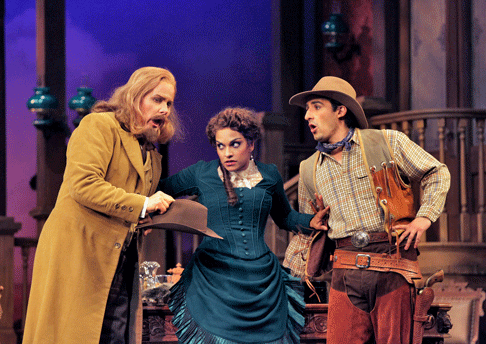 Jeff Mattsey as Dr. Malatesta, Danielle de Niese as Norina and Charles Castronovo as Ernesto
Jeff Mattsey as Dr. Malatesta, Danielle de Niese as Norina and Charles Castronovo as Ernesto
San Diego Opera was fortunate to have bass-baritone John Del Carlo as Don Pasquale. At this time in his career, Del Carlo is the very essence of Don Pasquale. His ringing voice and skilled acting allow us to see both the humor and pathos of the man. Tenor Charles Castronovo sang Ernesto, the young man in love with Norina, whom Pasquale wants to marry. Castronovo, whose sweet legato singing is always a pleasure, swaggered about appropriately in cowboy hat, chaps and boots. But I still can’t shake my recollection of him as the postman in Catán’s Il Postino. Lyric soprano Danielle de Niese, who recently performed the role of Ariel in the Met’s new The Enchanted Island, made her San Diego Opera debut in the role Norina. She’s one of the new wave of slim, young, athletic sopranos with lovely voices, who can sing bel canto arias while sitting, standing, lying down, or leaping from bed to chair. Baritone Jeff Mattsey in the role Dr. Malatesta, didn’t seem quite warmed up in the first act, but got his voice in the saddle by the second. His “cheti, cheti” with Del Carlo delighted the audience. Marco Guidarini, making his conducting debut with the company, led an uneven performance. There were some lovely passages and some sprightly playing, but there were moments when the orchestra lacked the vivacity with which the singers were performing. The chorus sang its one big number splendidly.
There is spaghetti served and eaten in this opera, but that’s not where the term “spaghetti western” comes from. If you don’t know its origin, look it up. It adds an interesting twist to the production.
Estelle Gilson
image=http://www.operatoday.com/DPSD1136.gif image_description=Danielle de Niese as Norina and John Del Carlo as Don Pasquale [Photo by Ken Howard courtesy of San Diego Opera] product=yes product_title=Gaetano Donizetti: Don Pasquale product_by=Don Pasquale: John Del Carlo; Dr. Malatesta: Jeff Mattsey; Ernesto: Charles Castronovo; Norina: Danielle de Niese; Notary: David Marshman; Hop Sing: Robert Dahey; Conductor: Marco Guidarini Director: David Gately. Costume Designer: Helen E. Rodgers. Lighting Designer: Harry Frehner. Chorus Master: Charles F. Prestinari. product_id=Above: Danielle de Niese as Norina and John Del Carlo as Don PasqualePhotos by Ken Howard courtesy of San Diego Opera
Aida in Arizona
They symbolize the buoyant optimism that surrounds this rising company after several years under General Director Scott Altman. Budgets are in the black and artistic quality is rising. Aida is an ambitious work for any company, and Arizona Opera delivered a strong performance on the first of five sold-out nights in Phoenix and Tucson.
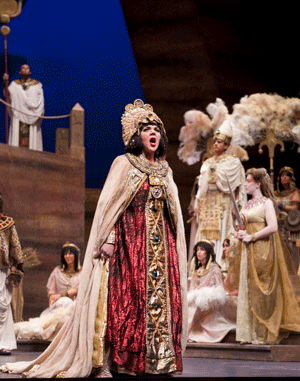 Daveda Karanas as Amneris
Daveda Karanas as Amneris
In an era where opera companies must watch the bottom line, conveying the grandeur of this spectacular work poses a unique challenge. Arizona borrowed a set from New Orleans Opera by Canadian designer Philip Silver, which provided two-dimensional, minimalist faux-massive painted drops, accessorized with exotic statues. The latter were sometimes in Egyptian style, with impressive results in the Nile scene, and sometimes just generically ancient. Nashville Opera Director John Hoomes directed in a traditional but effective manner. The Triumphal Scene parade inevitably seemed a bit thin, but the audience was distracted by live animals—two dogs and the return of one of the camels. To its credit, the set design pushed the action to the front of the stage, boosting the vocal acoustics in Phoenix’s large multi-purpose hall.
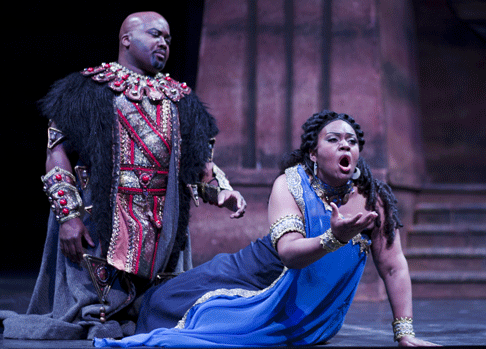 Kevin Short as Amonasro and Lisa Daltirus as Aida
Kevin Short as Amonasro and Lisa Daltirus as Aida
Aida was cast with a strong and well-matched set of regional-level American singers. To the title role soprano Lisa Daltirus brings a silvery tone, gossamer high notes, and intelligent phrasing. She used these qualities to make a memorable success of moments many sopranos fear, such as the infamous dolce high C in “O patria mia.” Yet the role of Aida demands not only this, but powerful low notes and passionate utterances that cut through heavy orchestration, which Datirus rarely delivers. While her characterization had integrity and pathos, at times she seemed to be tip-toeing through it.
Chicago-based Tenor Arnold Rawls is similarly more comfortable at the top than the bottom of the range required for Radamès. His lack of a fine-spun piano and unvarying color undermined quietly transcendent moments, as in most of the final scene; but elsewhere Rawls made satisfying use of vocal warmth, stentorian high notes, and fine phrasing. “Celeste Aida,” for example, was phrased impressively on one breath into the second verse, and—after some savvy preparation—ended on an impressively long and ringing b-flat.
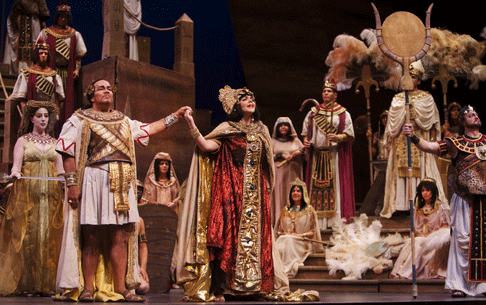 Rebecca Sjowall as High Priestess, Arnold Rawls as Radames, Daveda Karanas as Amneris and Peter Volpe as Ramphis
Rebecca Sjowall as High Priestess, Arnold Rawls as Radames, Daveda Karanas as Amneris and Peter Volpe as Ramphis
As Amneris, Greek-American mezzo Daveda Karanas, a graduate of cross-town Arizona State University, possesses a tightly focused, slightly steely voice that easily penetrated the orchestra—rather in the mold of Fiorenza Cossotto. Her interpretation is that of a mature artist, and she is a compelling actress. The voice lacks—perhaps as of yet—quite all the warmth, color and amplitude that the greatest exponents of this role possess, but her traversal of this role in a smaller theater—she is slated to sing the role at Glimmerglass Opera this summer—would be worth traveling to hear.
Altman favors even casts with strong voices in smaller roles, particularly lower male parts. Amonasro does not require great subtlety, and Kevin Short, an American baritone based in Europe, did not provide it—but he was commanding when it mattered. The veteran Ramfis, Peter Volpe, displayed a voice of impressive weight and color. In an era of soggy Verdi conducting, Steven White proved refreshingly willing to push the tempo along, achieved some lovely transitions and orchestral balances, and kept the forces together in the face of a few opening night mishaps.
Andrew Moravcsik
image=http://www.operatoday.com/OptGF3X9406.gif
image_description=Arnold Rawls as Radames [Photo by Tim Fuller / Arizona Opera]
product=yes
product_title=Giuseppe Verdi: Aida
product_by=Click here for cast and production information.
product_id=Above: Arnold Rawls as Radames
Photos by Tim Fuller / Arizona Opera
March 13, 2012
Miss Fortune mis-fires, Royal Opera House
It’s an anomaly in an otherwise fertile career, which has made Weir one of the significant British composers of our time. She deserves high profile tratment. So it’s just bad luck that while Weir is getting maximum attention, Miss Fortune does not show her at her best. Better a revival of A Night at The Chinese Opera or Blond Eckbert than this mishap.
The surmise is reasonable enough. Billionaire parents instantly lose all they have. “I’ll work, I’ll live, I’ll eat” sings Tina (Emma Bell) their daughter, “I’ll find my way on the street”. Perhaps, but the hardships she comes across are so sanitized that they’re hard to take seriously. Of course this is a fairy tale, but real fairy tales have bite. Miss Fortune is so shallow you couldn’t drown a gnat.
So don’t come expecting real emotions in this opera, and certainly no element of social analysis. The whole opera predicates on the idea of Fate in the form of a doppelgänger in a natty tie-dyed dressing gown. “I’m with you everywhere” sings Andrew Watts, trying his utmost to sound convincing, but there’s so little substance in this text that even he can’t bring out the malevolent possibilities in the character. Fate isn’t fair, it’s insane. Countertenors have the range to madden and confound, but the music here is so even-tempered that it makes little impact. When one of the breakdancers spins dangerously on the top of his head, risking his neck and spine, he expresses more about the nature of fate than anything in this music. It’s not a good sign when a choreographer can say more about the meaning of an opera than a composer. Wonderful dancing, however. These men (members of the Soul Mavericks) were so good that they almost rescued the whole show.
Lord and Lady Fortune (Alan Ewing and Kathryn Harries) have parts to sing that are more slapstick panto than depth, and Weir’s writing for them is very good, setting each at counterpurposes to the other, which expresses personality. But poor Tina! She’s such an inept cipher that Emma Bell hardly has to do much more than follow the notes. Hassan (Noah Stewart) and Donna (Anne-Marie Owens) are stock characters too, dutifully realized. .
The problem lies in the libretto. Judith Weir is brilliant at writing atmospheric, descriptive music, but such music needs something to hang on to, like flesh needs a skeleton (another image of Fate).This libretto is so weak, it’s embarrassing. The banality of the text follows the banality of the narrative, and the music doesn’t rise above it. For example, sharp-suited Simon the Yuppie (Jacques Imbrailo) comes down from his office (”it’s not far away”) to tell Donna the Laundromat Lady that his shirt is the best laundered and best ironed he’s ever worn. That’s about the level of discourse in this opera. The Deus ex machina is a lottery ticket which may or may not change Fate, but it’s so artificial we don’t really care. Imbrailo’s singing was by far the finest singing of all, exquisitely shaped and warmed with sincerity. Imbrailo is such a genuinely nice person in real life that perhaps he can identify with the better aspects of Simon. But the beauty of his singing was at odds with pedestrian vocal demands in the score. If only the part had been written with more substance, doing justice to this level of singing.
The staging on the other hand was superb. Wonderful set by Tom Pye, based on two triangular objects suspended above the stage, onto which were projected a fantastic array of light effects and videos (Scott Zielinski, Leigh Sachwitz, Flora and Faunavisions). This was truly magical. Inventive costumes (Han Feng) and strong direction by Chen Shi-zheng, who injects the proceedings with a charm lacking in the music. You could have spent the whole evening marvelling at this staging. Miss Fortune and the recent ROH Rusalka are mirror opposites, one with good music and dull staging, the other with wonderful staging and uninvolving music. But we shouldn’t go to the opera to enjoy the scenery, even when it’s as good as this. It’s the characters that make an opera, and their feelings, as brought out in the music.
Paul Daniel is an excellent and much underrated conductor who made his name in the ENO glory days when Weir and Turnage were in their prime. He has experience and inspired good playing from this orchestra, better than several conductors we’ve heard in recent months. Hopefully, he’ll be back again soon — he’s an asset.
There were so many positives about this production. It would be hard to imagine a better range of resources utilized to make it work. But Miss Fortune is fatally flawed because it just isn’t dramatic. I longed for Mark Anthony Turnage’s Anna Nicole, which has grown on me with time. Anna Nicole had its dull moments, but its grotesqueries were so engrossing that they held attention, even if they made you want to scream.
Anne Ozorio
image=http://www.operatoday.com/BC20120309693.png
image_description=Emma Bell as Miss Fortune [Photo by Bill Cooper courtesy of The Royal Opera House]
product=yes
product_title=Judith Weir: MIss Fortune
product_by=Tina Miss Fortune: Emma Bell; Lord Fortune: Alan Ewing; Lady Fortune: Kathryn Harries; Fate: Andrew Watts; Donna: Anne-Marie Owens; Hassan: Noah Stewart; Simon: Jacques Imbrailo. Conductor: Paul Daniels. Director: Chen Shi-zheng. Sets: Tom Pye. Costumes: Han Feng. Lighting: Scott Zielinski. Videos: Leigh Sachwitz. Flora & Fauna Visions. Choreographer: Ran Arthur Braun. Royal Opera House, London, 12th March 2012.
product_id=Above: Emma Bell as Miss Fortune [Photo by Bill Cooper courtesy of The Royal Opera House]
Judges and Finalists Announced for the 2012 Lotte Lenya Competition
Kurt Weill Foundation [13 March 2012]
Twelve exceptionally talented young singer-actors have made it through two rounds of auditions for the 2012 Lotte Lenya Competition and will compete for top prizes of $15,000, $10,000 and $7,500 in the finals, to be held on April 21, 2012, at the Eastman School of Music in Rochester, New York. Three-time Tony Award nominee Rebecca Luker, Broadway and Encores! music director Rob Berman, and Rodgers & Hammerstein Organization President and American Theater Wing Chairman of the Board Theodore S. Chapin will serve as judges.
March 12, 2012
Netrebko and Garanča in Donizetti’s Anna Bolena
Gaetano Donizetti’s first big success, Anna Bolena, serves as a “star vehicle” in the 2011 production from the Vienna State Opera, with Anna Netrebko in the title role and Elīna Garanča as Giovanna Seymour, Bolena’s rival for the attention of King Enrico VIII. As one of the composer’s longer operas, Anna Bolena tends to be something of a drag. The title character is unhappy from start to finish, and while the tragic conclusion has real power, too much of the rest of the score fails to rise above the workmanlike.
The female leads easily overshadow the two male leads, both very capable (Ildebrando D’Arcangelo as Enrico and Francesco Meli as Bolena’s supposed partner in royal infidelity, Lord Percy). The male roles only help to set up the opera’s other highlight, the confrontation between the doomed Queen and Seymour. In that scene Netrebko and Garanča bring a production to fierce life that, to that point, had been gliding along in somewhat perfunctory, if glamorous, fashion. For Netrebko, the role requires some of the bel canto dexterity that many critics find her lacking in. She shines in long lines and soaring passion, where her large voice can dominate the orchestra. Dramatically, she seems disengaged until the opera’s last scenes, however. Garanča’s Seymour earns the audience’s sympathy with her initial reluctance to accept the King’s favors, and the singer’s beauty helps as well, of course. While her voice certainly has a darker tinge than that of a soprano, Garanča is a careful, almost inhibited singer and not the sort of mezzo voice exhibited by a Marilyn Horne or Dolora Zajick. Those who want a bit more heat or even grit to the voice will be disappointed.
The production is either all meat, no potatoes, or vice versa, depending on one’s gustatory disposition. For some reason it took two designers (Jacques Gabel and Claire Sternberg) to come up with the stark and simple sets. The visual attraction all comes from Luisa Spinatelli’s luxurious period costumes. Eric Génovèse’s direction offers nothing new, even ending with Netrebko’s preferred pose of lying on her back (with a descending wall partition symbolizing the ax, one supposes).
Singer’s conductor Evelino Pidò maintains a strong pulse, and the female chorus at the start of act two is particularly beautiful. The only bonus features the set offers are brief spoken act summaries from Ms. Garanča. As a “star vehicle” then, Anna Bolena is done fine service by this Deutsche Grammophon DVD. Those who adjust their expectations will have a fine time.
Chris Mullins
image=http://www.operatoday.com/DG_0734728.gif image_description=Deutsche Grammophon 0440 073 4728 7 product=yes product_title=Gaetano Donizetti: Anna Bolena product_by=Anna Bolena: Anna Netrebko; Giovanna Seymour: Elīna Garanča; Enrico VIII: Ildebrando D’Arcangelo; Lord Ricardo Percy: Francesco Meli. Orchestra and Chorus of the Wiener Staatsoper. Conductor: Evelino Pidò. product_id=Deutsche Grammophon 0440 073 4728 7 [Blu-Ray] price=$39.99 product_url=http://www.arkivmusic.com/classical/album.jsp?album_id=665879
Finalists Named for Metropolitan Opera National Council Auditions
New York, NY (March 11, 2012) - The Metropolitan Opera today announced the names of nine finalists who will sing in the 2012 National Council Auditions Grand Finals Concert on March 18 at 3:00 p.m. with the MET Orchestra conducted by Andrew Davis. The finalists are: Janai Brugger, soprano from Darien, IL; Anthony Clark Evans, baritone from Owensboro, KY; Matthew Grills, tenor from Newton, CT; Will Liverman, baritone from Virginia Beach, VA; Margaret Mezzacappa, mezzo-soprano from Euclid, OH; Andrey Nemzer, countertenor from Moscow, Russia; Kevin Ray, baritone from Cornwall, NY; Lauren Snouffer, soprano from Austin, TX; and Michael Sumuel, bass-baritone from Odessa, TX.
A Physical Barber by ETO
For a start, it is rather long with copious quantities of plot and of recitative. Essentially it’s a fast paced farce, but one which is populated by believable, human characters thanks to Rossini’s music. But then, Rossini goes and throws in those long, stylised ensembles which sound fabulous but present the director with the problem of what to do. Some solve this by making the farce veer into slapstick, and other productions just aren’t funny (on Radio 3 recently the director of the Met, Peter Gelb, talked about one of their patrons not realising that The Barber of Seville was a comedy).
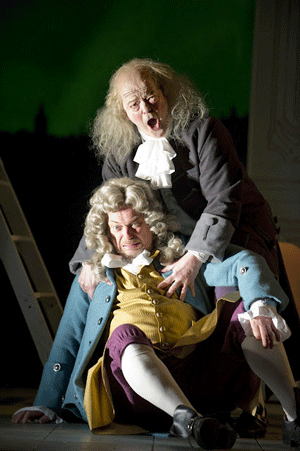 Andrew Slater as Bartolo and Alan Fairs as Basilio
Andrew Slater as Bartolo and Alan Fairs as Basilio
For ETO’s new production, which opened at the Hackney Empire on March 8th (we saw it on March 10th), director Thomas Guthrie opted for a very physical approach, but one that was strongly character based. The cast were all highly choreographed (the ensemble in the first scene actually break out into choreographed dance), but we never descended into slapstick, laughs always came because of the interaction on the stage not simply because a character was doing a funny walk. He kept the piece moving at a very fast pace and the talented, young cast responded by delivering recitative that was dramatically convincing and quick moving. The work was sung in English, in David Parry’s musical translation. The result was, as it should be, highly entertaining, you never felt that you were sitting through the recit simply waiting for the next aria, as can happen.
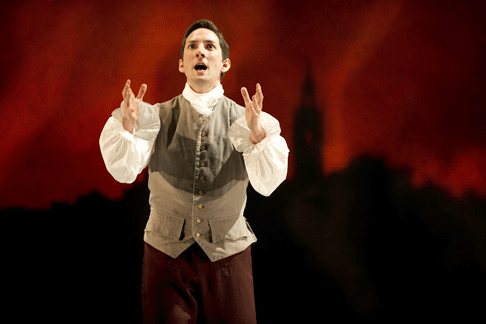 Nicholas Sharratt as Almaviva
Nicholas Sharratt as Almaviva
Rhys Jarman’s traditionally inspired designs consisted of a series of painted flats representing panelling; with judicious additions in each scene, these created a flexible series of playing spaces, both interior and exterior. All overlooked by a striking backdrop of a city-scape with a lowering sky. Colours were in a carefully chosen tonal palate, modern but classical; with Gillray style cartoons in modern colours as the pictures in Bartolo’s house. Costumes were traditional too, but the piece didn’t feel embedded in aspic.
The title role was played by Grant Doyle, who studied both in his native Australia and at the RCM. He was on the ROH Young Artists programme in 2001-3 and plans include the title role in Don Giovanni at Garsington. Doyle has a strong stage presence and effortlessly dominated, as Figaro should, without ever mugging. (Incidentally he played the guitar himself during the Act 1 serenade). His Figaro was rather a smug character, almost annoyingly so, but a charmer too. His account of ‘Largo al factotum’ was marred very slightly by balance problems, which reoccurred at other times during the performance; from our seat in the Dress Circle the orchestra sometimes was a little too strong for the singers, probably more to do with the acoustic of Frank Matcham’s theatre (which was built as a music hall) than anything else.
Kitty Whately won the Kathleen Ferrier Award in 2011 and currently studies at the RCM International Opera School. We saw her as Teodata in Flavio at ETO last year and were looking forward to her singing Rosina and we were not disappointed. Whately has a poised stage presence and gave the impression that Rosina was looking on the world, for the most part, in amused tolerance. A strong minded person, but lively and certainly attractive; she was touching in the closing scenes when Rosina thinks that she has been betrayed by Figaro and ‘Lindoro’.
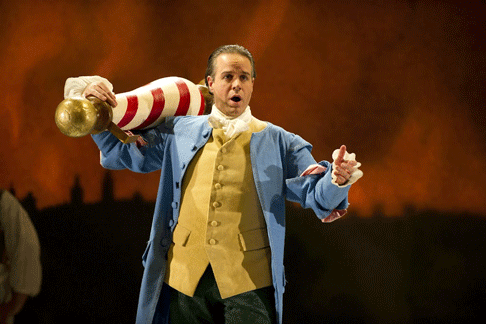 Grant Doyle as Figaro
Grant Doyle as Figaro
I have to confess that when it comes to the singing of passage-work both in baroque opera and early 19th century Italian opera, I am a bit of an obsessive; in an ideal world everything should be sung beautifully and cleanly. This Whately did, of the 3 main leads (Rosina, Figaro, Almaviva) all sang their passage-work confidently, expressively and creditably. But there were times when I felt that both Nicholas Sharratt (singing Almaviva) and Doyle were smudging things, but Whately’s divisions always seemed to come out cleanly.
She was partnered by the highly personable Nicholas Sharratt who has sung Nemorino at Grange Park Opera and Brighella (Ariadne auf Naxos) at Garsington. He has an attractive, quite slim-line lyric tenor voice with an easy top so that as Count Almaviva the tessitura of the role did not seem to hold terrors for him. As I have said, there were times when I felt he smudged his passage-work, but I warmed to his performance. His open stage presence and the way he developed a good rapport with Whately were endearing; plus he had good comic timing, he was funny without ever over doing things when playing the drunken soldier. He topped this by giving a fine account of the Count’s final aria, the showpiece which is usually cut and which Rossini re-used for La Cenerentola. After a long evening, Sharratt’s performance was quite brilliant and made a good dramatic case for including the aria.
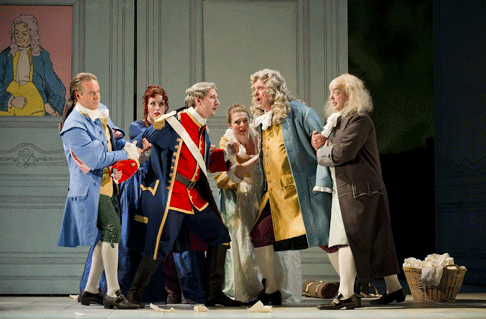 L-R: Grant Doyle as Figaro, Kitty Whately as Rosina, Nicholas Sharratt as Almaviva, Cheryl Enever as Berta, Andrew Slater as Bartolo and Alan Fairs as Basilio
L-R: Grant Doyle as Figaro, Kitty Whately as Rosina, Nicholas Sharratt as Almaviva, Cheryl Enever as Berta, Andrew Slater as Bartolo and Alan Fairs as Basilio
Andrew Slater has been an ETO regular for a few years now. He played Doctor Bartolo as an obsessively jealous dyspeptic, rather than being plain nasty. He coped manfully with having to do some amazingly botched comic surgery on patients during his Act 1 aria; one of the few moments when Guthrie’s ideas got the better of him. As with all good comedy, you felt sorry for Bartolo even though he behaved badly.
Alan Fairs was a hilariously scary Don Basilio and gave a strong, highly characterised account of the calumny arias. Cheryl Enever was a lively Berta, unfortunately deprived of her aria.
Conductor Paul McGrath kept things going at quite a lick, which was great for the comedy but which meant that co-ordination between pit and stage was not always quite what it should have been; this was particularly true in the big comic ensembles when Guthrie has his cast moving around. But it was an understandable error, given the desire to keep everything zipping along.
This was a performance full of energy and vivid character. Guthrie’s very physical approach to theatre was enthusiastically taken up by the cast. Despite the occasional problems, this was a performance that was funny and enjoyable in all the right ways.
ETO is performing the opera on tour in the UK until May 26th, along with Eugene Onegin and three children’s operas.
Robert Hugill
image=http://www.operatoday.com/Barber_ETO_01.gif image_description=Kitty Whately as Rosina [Photo by Richard Hubert Smith courtesy of English Touring Opera] product=yes product_title=Gioacchino Rossini: The Barber of Seville product_by=Count Almaviva: Nicholas Sharratt; Figaro: Grant Doyle; Rosina: Kitty Whately; Doctor Bartolo: Andrew Slater; Berta: Cheryl Enever; Don Basilio: Alan Fairs; Ambrogio: Andrew Glover; An Officer: Brendan Collins; A Notary: Maciek O’Shea. Conductor: Paul McGrath. Director: Thomas Guthrie. Designer: Rhys Jarman. Lighting: Guy Hoare. Translation: David Parry. product_id=Above: Kitty Whately as RosinaPhotos by Richard Hubert Smith courtesy of English Touring Opera
March 9, 2012
Byrd: The Englishman
Following their highly praised recording of Byrd’s complete Latin church music, they have now embarked upon a nine-month tour that will take them to venues spread across the width and breath of the UK, beginning with this assured recital at London’s Wigmore Hall.
Byrd’s Great Service — the most substantial of his compositions for the English rites — belongs to the early-English Great Service tradition established by John Shepherd, Robert Parsons and William Mundy, being neither ‘full’ not ‘verse’ in a conventional sense but calling for soloists and full choir. Despite Archbishop Cranmer’s ecclesiastical injunction, intended to ‘simplify’ church music during the English Reformation, that compositions for the church should be “not full of notes, but, as near as may be, for every syllable a note”, Byrd did not resist the temptation to musically expand the words at will, to reflect the glorious texts.
The Cardinall’s Musick communicated with unfailing emotional directness; the singers made it clear that the extension of the text is a perfect expression of its sentiment and feeling, as in the Benedictus where they relished the splendidly rich development of “all the days of our life” which depicts the sincerity of man’s eternal devotion.
The Service predominantly employs five-part polyphony but divides into six, seven and eight parts — even 10 on one occasion. This is demanding music, both intellectually and musically, and this performance was characterised by remarkable textural lucidity, as the voices intricately dovetailed and interweaved. The singers skilfully painted colour and underscored contrasts, never in a mannered fashion, but revealing an intimate understanding of the way Byrd combines a myriad of different vocal registers and groupings. Individual voices rose from the seamless whole and melted effortlessly back into the blend; but there’s is no homogenous, emotionally restrained timbre — rather the individual voices have a vivid immediacy and distinctive character.
The group brought vigour and energy to the wide range of harmonic and melodic rhythms employed by Byrd. Phrasing was uniformly beautiful, but there was also much freedom and elasticity in the melodic lines, with the introduction of compound rhythmic groupings within simple time signatures. Such versatility — the union of strength and suppleness — was entrancing.
Similarly the surprisingly complex rhythmic combinations of the Benedictus, “To give light to them that sit in darkness, and in the shadow of death”, were both magical and awe-inspiring, as the singers observed the idiosyncratic accents in individual vocal parts. Much charm resulted also from thoughtful emphases of chromatic and harmonic nuances; in the Benedictus, the flattening of the tenor’s line, “Through the tender mercy of our God”, combined with the delicate decoration of “tender” by the second alto II was deeply affecting. Throughout the singers confident embraced Byrd’s harmonic boldness, particularly at the end of the Magnificat.
Most striking was the power of the full choir entries, and the elaborate developments and repetitions; in the Te Deum, “Let me never be confounded” was majestically assertive, an arresting contrast with the poignant tenderness of the Magnificat’s depiction of the Virgin, “the lowliness of His handmaiden”. The latter movement also offered the most exciting passages, “He have scattered the proud” — in which the rhythmic motifs literally scattered the words dynamically across the score — and the eight-part, “He hath put down the mighty from their seat”, in which voice after voice leaps down in a sequence of dramatic descending intervals.
Interspersed between the movements of the service were anthems dating from both the beginning and end of Byrd’s compositional career. Of particular note was ‘Prevent us, O Lord’, in which the singers controlled the tightly compressed imitative texture, two- and three-voice units merging seamlessly with dense homophonic passages in the lower register in a flexible fashion. And, whatever Queen Elizabeth I’s awareness of Byrd’s instinctive religious sentiments, she would surely not have failed to be moved by this performance of ‘O Lord make thy servant’, in which the very close imitation at “give her her heart’s desire” conveyed the composer’s love and loyalty. For the final ‘Amen’, the soprano serenely sustained the tonic while movement in the lower parts built through a moving crescendo before receding to a calmer resolution.
Given the usual ecclesiastical context of this repertoire, one might have misgivings about performances in secular venues. However, the Wigmore Hall surely comes close to the intimate rooms — private chapels or the Chapel Royal in St James’s Palace — in which Byrd intended such music to be experienced. As the singers arranged themselves antiphonally beneath the Hall’s half-cupola, I anticipated an air of reverence despite the lack of ecclesiastical resonance and expanse. The architectural grandeur and variety of the ‘Amens’ might alone craft a devout mood. Indeed, the singers’ resonant tone was never arid. And, the amazing seven-part Amen to the Benedictus, with its precipitate entries and grandiose upwards sweeping scales, one following another, was breath-taking.
However, the performance never quite achieved the elevating spiritual level for which one might have hoped. The insertion of the anthems interrupted the accumulating spiritual force of the unfolding movements of the service. And, this was exacerbated by Carwood’s spoken introductions before various stages of the service — pleasant and informative they may have been but were they really necessary given that the concert was preceded by a pre-performance talk? Together with the audience’s applause, which Carwood himself ‘permitted’ in his opening welcome, these elements somewhat disturbed the reverential ambience.
One more minor quibble: Byrd’s rhythms present an effortlessly natural accentuation of the English language and it was disappointing that at times that the text was not always distinctly enunciated. But, what was never in doubt was the musical intelligence and deep expressivity of The Cardinall’s Musick. The concert certainly achieved Carwood’s aim to “take Byrd around the country, to showcase his passion and to place him in context as the most important musician of the Tudor age”.
Claire Seymour
Programme:
Venite from The Great Service
O Lord make thy servant Elizabeth our Queen
Te Deum from The Great Service
Prevent us, O Lord
Benedictus from The Great Service
Praise our Lord, all ye Gentiles
Magnificat from The Great Service
Turn our captivity, O Lord
Sing ye to our Lord
Come, let us rejoice unto our Lord
Nunc dimittis from The Great Service
Click here for information regarding the William Byrd Edition by Cardinall’s Musick. image=http://www.operatoday.com/William_Byrd.gif image_description=William Byrd product=yes product_title=Byrd: The Englishman product_by=The Cardinall’s Musick. Andrew Carwood, director. Wigmore Hall, London, Monday 5th March 2012. product_id=Above: William Byrd
The Los Angeles Opera — A Cultural Icon in Downtown LA
Opera was no stranger in LA as it arrived in 1900 with the American premiere of Puccini’s La Bohème. The venue, Hazard’s Pavilion, remained open until it was demolished in 1906. No less than Enrico Caruso starred in a production of Carmen in Los Angeles.
The Los Angeles Opera is an offshoot to the Los Angeles Civic Grand Opera, established in 1948. The LACGO eventually abandoned its production unit, and brought in touring opera companies from major cities, under the direction of the Music Centre Opera Association.
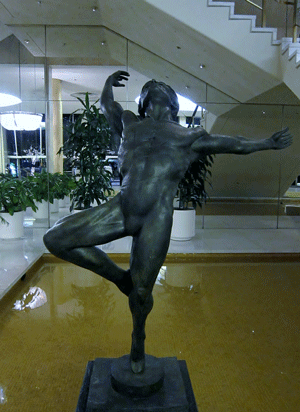
Peter Hemmings was appointed general manager of the Music Centre Opera Association in 1984. One of his duties was to establish a local opera company that would produce its own works that became the Los Angeles Opera.
The renowned Spanish tenor, Plácido Domingo, appeared in the inaugural production of the company starring in Verdi’s Othello and continued on as an artistic consultant. Besides his duties as artistic consultant, performer and conductor with the company, Plácido Domingo, was named the director of Los Angeles Opera in 2003. His contract runs until 2013.
The company engaged prominent guest artists into productions under the direction of Domingo. This immediately attracted the attention of opera aficionados, the public and media. Since its inception, Los Angeles Opera has participated in Education and Community Programs that have offered students, senior citizens, and other audiences the chance to experience the opera. With perseverance and dedication, the Los Angeles Opera is considered to be the “fourth largest opera company in the United States.”
The Los Angeles Opera tends to create innovative productions, its recent Ring cycle being particularly notable.. At its peak, the company ascended to ten productions with 75 total performances during its 2006-07 seasons. However, the recent economic downturn forced the company to scale back. For the 2011-2012 season, they dropped down to six productions with 37 total performances.
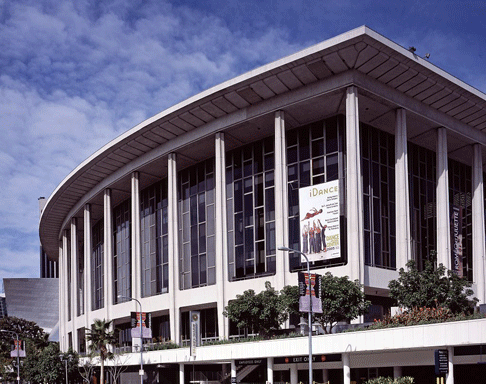
The number of productions remains the same for the 2012-2013 season with the focus on the company premiere of an early opera by Verdi, The Two Foscari. Plácido Domingo will be starring with music director James Conlon conducting. Other scheduled productions are Mozart’s Don Giovanni, Wagner’s The Flying Dutchman, Puccini’s Tosca, Rossini´s Cinderella and Puccini´s Madame Butterfly.
The 3200-seat Dorothy Chandler Pavilion is home for the Los Angeles Opera. The theater was designed by architect Welton Becket, and opened in 1964. It is the largest performance venue at the Los Angeles Music Center.
Veronica Shine
Planning a Visit:
The Dorothy Chandler Pavilion is located within the Los Angeles Music Center at 135 N. Grand Ave. Paid parking facilities are available at the Music Center.
The venue can also be reached via public transportation.
By DASH bus: Both the “A” and “B” routes have stops at the Los Angeles Music Center. Check times of operation.
By Metro Train: Take the Red Line or the Purple Line to Civic Center (two blocks from Dorothy Chandler Pavilion) or via the Gold Line to Union Station, then DASH “B” line southbound from Union Station to Dorothy Chandler Pavilion.
The box office sells tickets for individual performances and in ticket packages. Hours for purchases are Tuesday through Saturday, 10am - 6pm (8pm on performance days), Sunday matinees: 10am - 6pm.
Find accommodations near Dorothy Chandler Pavilion by visiting LosAngeleshotels.org. The Los Angeles Music Center is within walking distance of hotels located in downtown LA.
image=http://www.operatoday.com/la-opera-1.gif image_description=Photo by Calvin Fleming product=yes product_title=The Los Angeles Opera — A Cultural Icon in Downtown LA product_by=By Veronica ShineMarch 8, 2012
Elijah, Barbican Hall, London
My preference for the German version is neither here nor there, really, given the commission for the Birmingham Festival, and certainly not when it is performed in a series devoted to English-language oratorios. However, it is interesting to note the difference in sound; indeed, it is almost impossible not to notice it. Bach seems more distant, at least for much of the time, though it is not necessarily the case that Handel seems closer. For better or worse, we seem closer to the world of Victorian piety. (Consider, in a celebrated example, how different ‘O for the wings of a dove’ and ‘O könnt' ich fliegen wie Tauben dahin’ sound.)
One aspect, however, of the present performance could not have been more different from the world of the Victorian choral society, namely the size of the forces involved. This was a chamber Elijah, both in terms of choir and orchestra. The Britten Sinfonia’s instrumental forces included strings scaled at 8:6:4:4:2, wind instruments and timpani, whilst Britten Sinfonia Voices numbered thirty-four in all, quite a contrast with the previous time I had heard the work, from a fully symphonic London Philharmonic Orchestra and London Philharmonic Choir under the baton of Kurt Masur (in German). The soloists were fewer in number too, limited to just the five, including a treble. The Barbican is a smaller venue than the Royal Festival Hall, though it is certainly not a chamber venue, and there were times when I missed the heft that could be imparted by larger forces — not because they are in some dubious sense ‘authentic’, but more on account of the near-Wagnerian dramatic scale they can assist to convey. One’s ears adjust, though, at least to an extent, and clarity provided some degree of compensation.
The Britten Sinfonia is generally acknowledged to be one of this country’s most enterprising ensembles, its programmes regularly proving more interesting, more imaginative, than many longer established groups. Based in Cambridge — during my time there, I attended a good number of its lunchtime and evening performances — it has recently been appointed an Associate Ensemble at the Barbican. Though that appointment will begin in autumn 2012, coinciding with the Sinfonia’s twentieth anniversary, this concert offered Barbican audiences a taste of what will be on offer: obviously not so much in programming terms — Elijah is Elijah — as in musicianship. My only real doubt concerning a fine orchestral performance was a certain stinginess concerning string vibrato during the Overture. Otherwise, all sections of the chamber orchestra emerged with great credit, from the opening sepulchral, stentorian woodwind, to the blaze of the final ‘Amen’. There was some very fine solo work too, for instance from obbligato cello (Caroline Dearnley) in Elijah’s recitative, ‘It is enough,’ and oboe (Alun Darbyshire) in his arioso, ‘For the mountains shall depart’.
Likewise Britten Sinfonia Voices, recently formed under the leadership of Eamonn Douglas, acquitted themselves extremely well. There were indeed times when I had to remind myself that they were relatively few in number. Diction and clarity were excellent; there was never the slightest hint of (pseudo-)Victorian staidness. Only once did I find the choral singing a little tame, in the chorus ‘Baal, we cry to thee,’ but the lack of wildness — and this is Mendelssohn, after all — seemed more a matter of direction by Andreas Delfs than of the singing as such. At any rate, the call of the priests of Baal to their god to ‘hear and answer … Mark how the scorner derideth us!’ soon registered less ‘tastefully’ and with far greater dramatic force.
Delfs I was less sure about. For the most part, his was a capable performance. Only occasionally, most notably during the Overture, did he drive the music too hard. On the other hand, and despite a truly thrilling chorus to conclude the first part, this was not a reading to grip one dramatically as Masur’s had done. The comparison may be odious, but, especially when we are dealing with a work and indeed genre that remain unfashionable, an extra ounce of musico-dramatic conviction can work wonders. It is probably fair to say that Mendelssohn’s inspiration is uneven here, not least in some of the numbers towards the end of the second part, but fiery advocacy can help persuade one otherwise. Some of these numbers dragged, alas, lending an impression of chamber-scale neo-Victoriana, petering-out Stanford rather than invigorating Handel.
There was much, nevertheless, to relish in the solo singing. Simon Keenlyside made an excellent Elijah, not a bluff prophet, but a thoughtful, sometimes even conflicted soul, sensitive to an unusual degree, whether in terms of characterisation or verbal acuity. The pathos to his delivery of ‘It is enough…’ reminded one, despite the language, of Bach: recitative it might be, but Keenlyside — and, I think, Mendelssohn too — brought the music, not for the first time, closer to arioso. Mendelssohn at his most Handelian, in the aria ‘Is not his world like a fire?’ was conveyed with equal success, echoes of the Messiah readily discerned. Lucy Crowe offered a particular highlight with the aria that opens the second part, ‘Hear ye, Israel’. Clear of tone and direct of expression, this was model oratorio singing, as were the contributions from Catherine Wyn-Rogers. Wyn-Rogers had considerable ground to cover, but moved effortlessly between Angel and Queen. The latter — Jezebel, of course — exuded menace and feminine wiles, whilst the Angel’s ‘O rest in the Lord’ revelled, for better or worse, in Mendelssohn at his loveliest. After an unfortunate start, treble William Carne made up lost ground and offered a number of well-turned phrases. The only real disappointment was tenor, Andrew Kennedy. Oddly, his single line as Ahab offered properly dramatic impact, but much of the rest of his performance suffered from an awkward combination of overt emoting and a tendency to croon. Obadiah was bad enough, but the final, tenor aria, ‘Then shall the righteous shine forth,’ sounded as if it were excerpted from a West End musical, vibrato so wide as to disconcert. Fortunately, there was some excellent choral and orchestral playing still to come.
Mark Berry
image=http://www.operatoday.com/elijah_rubens.gif image_description=The Prophet Elijah Receiving Bread and Water from an Angel (1628) by Peter Paul Rubens product=yes product_title=Felix Mendelssohn: Elijah, op.70 product_by=Simon Keenlyside (baritone); Catherine Wyn-Rogers (mezzo-soprano); Lucy Crowe (soprano); Andrew Kennedy (tenor); William Carne (treble); Britten Sinfonia Voices (chorus master: Eamonn Douglas); Britten Sinfonia/Andreas Delfs (conductor). Barbican Hall, London, Wednesday 7 March 2012. product_id=Above: The Prophet Elijah Receiving Bread and Water from an Angel (1628) by Peter Paul RubensMarch 6, 2012
Abduction from the Seraglio, Philadelphia
Despite its robust comedy, technical difficulty, and occasional exoticism, Mozart’s music is youthfully transparent. His fresh score transforms eternal stereotypes—two noble lovers, a spunky English maid with her enthusiastic if naïve boyfriend, and the crude barbarian overseer who would thwart them—into uniquely memorable individuals whose feelings we seem to intuit directly.
This emotional honesty poses a challenge for theater directors, whose attitude toward this work has changed several times in my experience. Until well into the second half of the 20th century (and in provincial performances still), Abduction was presented as a robustly German comic romp. Several generations ago, Giorgio Strehler and others sought to elevate such productions by stripping away tired slapstick routines to reveal the full range and depth of underlying humanist sentiments. Over time, however, most such productions came to focus excessively a stylized dilemma facing Konstanze whether to love Bassa Selim or Belmonte—despite the lack of any textual or musical support for an inner conflict. Over the past decade, the opera has gained new notoriety as the object of Regietheater excess. In search of an underlying social message, Calixto Bieito famously set it as a dystopic story about human trafficking, featuring masturbation, oral sex, urination, and much violence. In a much discussed scene, Osmin hacks up a whore and offers her bloody, severed nipples to Konstanze—an interpretation widely criticized for violating the spirit of Mozart’s music.
Philadelphia’s new production (shared with Treviso) faces the Abduction challenge with a new and intriguing conceit. It resurrects the notion of a “rescue opera”—a popular 18th formula, of which this opera is an example, whereby noble Europeans are saved from oppression and bondage—and seeks to update it with stock characters, styles and settings from silent movies. The Seraglio becomes Constantinople in 1918 (the supertitles anachronistically call it Istanbul), Bassa Selim becomes Ataturk, and Konstanze becomes a British spy seeking to pry secrets from the Turks during World War I. It suggests a fresh set of images, drawn from an era with which a modern audience can better identify, yet also in which individuality, femininity, and the relationship between East and West were being redefined in interesting ways. A promising premise…
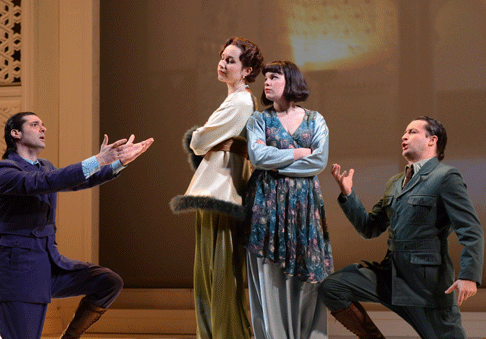 Antonio Lozano as Belmonte, Elizabeth Zharoff as Konstanze, Elizabeth Reiter as Blonde and Krystian Adam as Pedrillo
Antonio Lozano as Belmonte, Elizabeth Zharoff as Konstanze, Elizabeth Reiter as Blonde and Krystian Adam as Pedrillo
Yet the production only skims the surface of the concept, with tame results. By the end of the overture, the spy story disappears (just as well, since Konstanze is no spy). At times the background features a silent movie, but this is applied randomly, rather than being exploited consistently to underscore the action. Surely it would not have been hard to find engaging parallels: Belmonte and Konstanze, as well as Pedrillo and Blonde, do resemble the virtuous couples who inhabit silent films, while Osmin does recall villains like Chaplin’s “Big Eric.” Yet the projections provide little more than local color: generic scenes and, at the end, just a quarter hour shot of an old postcard of Hagia Sofia. Beyond the backdrop, the production is remarkably old-fashioned, even provincial, with overheavy reliance on crude gags, garish costumes, and harem girls. A quarter of an hour in, watching Osmin, clad in bright yellow, chasing Pedrillo with a whip, one acknowledges it will be a long afternoon.
Still, a major advantage of the unconventional “movie screen” set design is its theatrical and acoustical intimacy—a plus in this intimate work. It pushes action to the front of the stage, where two ramps permit the singers to cross through the first row of the audience. Thus the burden rests on the singers to carry the show. Yet here, too, the performance gets stuck half-way. Today there is no shortage of great Baroque and Mozart singers, yet one rarely encounters a major house cast as uneven as this one.
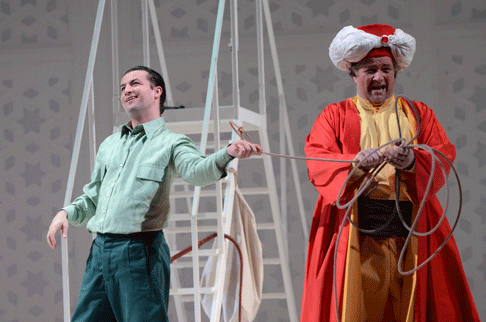 Krystian Adam is Pedrillo with Per Bach Nissen as Osmin
Krystian Adam is Pedrillo with Per Bach Nissen as Osmin
Young soprano and Curtis student Elizabeth Zharoff possesses a warm, even, and well-placed voice, solid coloratura technique, and considerable innate musicality that could take her far in the opera world—and she looks good on stage. Yet Konstanze is a bit of a stretch. In her mid-20s, Zharoff does not quite yet possess the weight and vocal glamor for showpieces like “Martern aller Arten” or “Ach ich liebte” in a big house. She would be more appropriately cast as Pamina, which she will sing next year in Philadelphia.
Never before have I heard a Belmonte who sounds more comfortable in “Ich baue ganz”—the Act III aria often ducked by even the best tenors due to its daunting technical difficulties—than in the two more famous arias of Act I. Spanish Tenor Antonio Lozano brings many things to the role—a voice of reasonable size, clean passagework, and an ardent manner—but not what the role of Belmonte requires above all else, namely noble phrasing and smoothly elegant vocal production. Uneven color and intonation, as well as Spanish-accented German that seems not that of a speaker (let alone native speaker) of the language, weigh him down musically and theatrically.
Polish tenor Krystian Adam sings and acts superbly in the character role of Pedrillo. The young Curtis grad (now in Frankfurt) Elizabeth Reiter is, as her previous work with Philadelphia has shown, a splendid singer on her way up. She sings with a full tone, compelling phrasing, and precise intonation. Yet she seems vocally uncomfortable as Blöndchen, a role Mozart crafted especially for a soubrette with unusually free high notes. Singers with the dark bass voice for Osmin are an endangered species. Nissen sings Osmin at a solid European provincial level, but lacks a booming low D or any other special attribute for the role, though his diction is the best in the show.
Music director Corrado Rovaris conducts crisply, in a style aimed somewhere between the modern and period, and only occasionally let the ensemble slip. Yet the result is neither idiosyncratic nor idiomatic. One waits in vain for the rubato or graceful turn of phrase that would breathe life into this wonderful score.
Andrew Moravcsik
image=http://www.operatoday.com/Abduction_Phil_01.gif image_description=Elizabeth Zharoff as Konstanze, with Peter Dolder as Pasha Selim and Antonio Lozano as Belmonte [Photo by Kelly & Massa Photography courtesy of Opera Company of Philadelphia] product=yes product_title=W. A. Mozart: Abduction from the Seraglio product_by=Click here for cast and other production information. product_id=Above: Elizabeth Zharoff as Konstanze, with Peter Dolder as Pasha Selim and Antonio Lozano as BelmontePhotos by Kelly & Massa Photography courtesy of Opera Company of Philadelphia
March 5, 2012
Paris: Tenors Trump Befuddled Productions
Remember Max, the hapless impresario in Mel Brooks’ The Producers? His auditor opines that no one investigates where the money goes after a show flops, so if he over sold the shares to investors, he could pocket the money with virtual impunity. Max puts on the worst possible, sure-fire flop, Springtime for Hitler. Except somehow, it becomes a hit. Based on the SRO status of the current egregiously misrepresented Manon maybe an accountant should be called to investigate where our ticket money was spent. ‘Cause it sure ain’t in the service of Massenet.
It can only be owing to Natalie Dessay’s star power that ‘the producers’ felt this Manon could possibly merit approval/interest. For those who remember the near flawless, Fragonard-inspired version late of New York City Opera, which was all of a (period) piece, this mixed bag of a design was as alienating and angering as it was confusing.
Elsa Pavanel’s eclectic costumes were perhaps the worst visual polluters. For no good reason, Lescaut was Almighty Goth, a leather-wrapped, chain-weighted, spiky-haired thug. Bretigny’s evening was spent in the burgundy palette, first in a satin disco suit, then Goth-icized in Act II, and later Goth-damn-it-all, in a swishy frock coat. Des Grieux first swam upstream in a tailored salmon-hued 40’s suit. Trixie, Dixie and Nixie (um, I mean Pousette, Javotte, Rosette) were each adorned in completely different period garb. In real time it was Mardi Gras, so maybe Ms. Pavanel was suggesting that this grab bag of motley variety just — ‘oopsie’ — spilled from the streets onto the Bastille stage. What else could explain first attiring the Chorus in (the correct) period court dress, then having them appear to have wandered in straight out of Meistersinger, then having the ladies got up in early 20th century day dresses? It may have still been Carnival in the real world but in the theatre we were already mired in Lent, the production awaiting redemption in vain.
There was nothing so awfully wrong about the massive set design created by Jean-Marc Stehlé and Antoine Fontaine. It just never added anything atmospherically to the effort. The huge staircase and upper landing of Act I seemed more indoor castle hall than outdoor courtyard, this in spite of the entrance of a 1950’s tour bus announcing its destination as Amiens.
Act Two’s simple garret has a seriously confused sense of architecture, with the one door up center used only by Des Grieux and a Concierge (who, no kidding, delivers pizza in a box just before the hero leaves to post his letter). Others entered from the wings, seemingly walking through the ‘walls.’ Nor was any of this helped by Hervé Gary’s sputtering, bluntly cued lighting effects, which many times left actors unlit. In what had to have been a miscue, all illumination abruptly went out on Manon at the end of Act II and she was left to make a long, arching exit off stage in the dim reflected glow of the pit’s music stand lights.
The Cours la Reine scene was arguably the least offensive with its pillars of flora and fauna set in a conservatory. If only the costumes had not evoked ‘Alt-Nürnberg.’ Having the foliage fold up and the pillars turn to become the interior of St. Sulpice was a decent enough effect, until the chorus ladies appeared on contemporary roller skates in the afore-mentioned 1920’s day dresses, like some demented, cut-from-the-final-print, what-were-we-thinking production number from “Xanadu.” (There’s a “Filles on Wheels” joke here somewhere but I can’t quite figure it out…). By the time we got to the Oh-My-Goth Casino all bets were off, as Manon flounced in looking like “Tommy’s” Acid Queen in her jeweled, distressed dress and a shock of a red fright wig.
As if it could get any worse, key moments were “captioned for the clinically bewildered.” Manon sings of jewelry, and a spot lit portrait of a beauty queen wearing a ‘Miss Arras’ banner and tiara flies in. As Des Grieux intones his reverie, he is upstaged by a framed paint-by-numbers front yard landscape, then (as if distracting us once was not enough) adding a mom with a frying pan, with dad and the kids in a Thunderbird straight out of a 1950’s magazine ad. When Daddy Des Grieux sings, his wedding photo descends, and on and on ad nauseam. Willfully provocative.
Director Coline Serreau must bear the brunt of the blame for these avoidable mis-steps, and more. Her placement of singers was most usually in total disregard of both the high caliber of her starry cast and the script’s requirements. All applause after set pieces is discouraged/eliminated (example: the priest speaks added comments and squelches the end of “Ah, fuyez…”). Seldom does anyone look at another character, but rather sings straight front. As Manon intones “N’est-ce plus ma main que cette main presse?” she is as far away from her intended press-ee as the space allowed (short of actually being off stage).
Mme. Serreau also injects coordinated moves into certain sections that are more “Folies Bergère” than Massenet, witness the girls’ trio, hopping, bopping, and moving their heads from side to side as they gestured wildly like demented Supremes. Indeed, there is so much extra-musical “invention” that it seems like Coline was hell-bent to throw so many ideas at us that she hoped one might stick. Having the Love Couple escape to Paris on a motorcycle at the end of One was a decent idea, but it was utter nonsense when Lescaut drove the cycle into St. Sulpice and plucked up the couple after their impassioned duet.
Did we need to be ‘entertained’ by guys in laborer jumpsuits rolling on shopping carts of groceries and tossing them to other workers up the stairs and off stage as the Innkeeper sang of the food? And while much of the ballet was (in this case) mercifully cut, it is hard to know what the runway fashion parade was all about, with lithe models got up in Victoria’s Secret, three male hunks hung with chiffon ballet skirts, a smattering of S&M accessories, and the whole lot of them silenced with tape over their mouths. Hmmmm. Perhaps they attempted to tell the director what they really thought of it all? Hmmmmm.
One final unfortunate consequence of the massed milling about in group scenes is that Patrick Marie Aubert’s usually fine chorus, was atypically raggy and at times, downright muted. Serreau has a lot of explaining to do…
At this point in her successful career, the oft-sensational lyric-coloratura Natalie Dessay has branched out to heavier roles with somewhat variable results. Ms. Dessay is a supremely talented actress with few equals, however Manon demands more than dramatic acumen. These days, Ms. Dessay affects a slightly fuller, more pointed sound which serves her well in the upper, and upper middle range. She still reigns supreme in forays above the staff where her tightly-focused soprano can soar above the orchestra.
Alas, the more the phrasing dips into the lower middle, the less ‘present’ it becomes, and a (very) slight rasp can creep into lower phrases when she infrequently presses them. Still, her upper full voiced singing was free and clear, and possessed all the accustomed vitality and zing. Best of all, she looked petite, lovely and utterly believable, even when got up in improbable attire. Her golden blonde wig looked lovely, and when she stole into Sainte Sulpice in a diaphanous, hooded black cape she suggested the ultra -glam Witch from Into the Woods. While Manon is certainly a more comfortable fit than her recent encounters with Violetta, I keep wishing Mme. Dessay would go back to her former territory, in which she was always queen of the night.
Though Giuseppe Filianoti may not be a natural stage creature, he strives (to mostly fine effect) to be theatrically engaging. But there is no denying his was the star vocal presence of the night. Not for him the suave styling and crooning of say, Alfredo Kraus. Signor Filianoti can spin a tender line to be sure, but he is happiest when he can go for the jugular, and when he delivers the impetuous top notes he lands them right between your eyes. To his credit, his full-bodied approach complemented his leading lady quite well, and he was a generous and deferential colleague. But when firepower was required, Giuseppe provided salvo after salvo. He deserved a far better costume than the unflattering slacks and clinging knit top that he got stuck into for the last third of the opera. But never mind, by that point we were closing our eyes, and what we were hearing from him was uniformly exciting.
Franck Ferrari’s Lescaut was so solidly sung it helped us overlook his irritating get-up. Paul Gay contributed a sympathetic, clear-voiced Count des Grieux. Luca Lombardo was a sassy, un-stereotypical Guillot, and André Heyboer contributed a wholly competent de Brétigny. The often forgettable ladies trio was here made memorable by the clear-voiced, evenly matched, excitingly delivered solos and harmonies from Olivia Doray (Pousette), Carol García (Javotte), and Alisa Kolosova (Rosette). An unexpected delight.
I have admired conductor Evelino Pidò on other occasions, but on this evening he did not exude his usual presence, personalized point of view, or control. There was nothing wrong with the orchestra’s efforts, but the result was lacking in the last measure of effervescence that can lift Manon to a higher plane. I had the overall impression that the assembled artists might be trapped in an endeavor not wholly to their liking. Indeed, Natalie Dessay said as much, announcing her withdrawal from opera for a year owing in part to her experience with this production. When internationally applauded star singers are pushed to these measures, perhaps producers might look at what really draws patrons to buy opera tickets? (Hint: It is not to see the likes of Coline Serreau’s self-indulgent, inept direction. Just sayin’…)
Things were happily in far better order the next day with the mesmerizing musical execution of The Queen of Spades. Once again, and perhaps not unsurprising, the tenor took the laurels, this time owing to the muscular, rapturous, balls-to-the-wall vocal outpouring from Vladimir Galouzine. His is one of the biggest natural voices on display today, but that is not to imply that Mr. Galouzine does not also have finesse. Indeed, he created a multi-faceted Hermann, completely capable of sensitive, controlled vocalism at moderate and soft volumes. But when the money notes are called for, he can pour on the stentorian steam like few others. Vladimir sustained this spell over the audience for the entire piece, no small feat since, in this concept, he never leaves the stage.
Olga Guryakova was a secure, if a bit cautious Lisa. The hint of metal in her full-voiced top notes served her quite well, and in the more conversational middle passages her instrument assumed a richer, vibrant sheen. But on this occasion, Ms. Guryakova came across as on the outside of the role looking in, well-voiced but unengaged. Not so home boy Ludovic Tézier whose rich baritone ravished us with gleaming, deeply felt phrasings as a powerful Prince Yeletski. The celebrated mezzo Larissa Diadkova confirmed her reputation with a vocally distinctive Countess that was at once plush velvet and barbed commentary. Count Tomski was ably taken by Evgeny Nikitin, who commanded his every scene.
Best of all, conductor Dmitry Jurowski drew stylistically informed, dynamic ensemble playing from the orchestra; supremely responsive singing from the soloists; and full-throated vocalism from a chorus confidently back on form (Chorus Master, Alessandro di Stefano). There was no musical effect that escaped Maestro Jurowski’s detailed attention, and the shaping of the entire opera was wonderfully calibrated.
The good news is that the setting (David Borovsky) was most professionally executed and highly realistic in detail. The bad news is that the Concept sets the entire piece in a Soviet era asylum, where a bed-ridden Hermann is what…dreaming? Hallucinating? Reminiscing? Small matter, since the bottom line is we are stuck looking at a slime green, paint-peeling, bare bones loony bin, and it is unsurpassingly ugly. Make that “Fugly.” (Figure it out…)
Still, with this as a (depressing) ‘given,’ the dramatic conceit works after a fashion. Since Hermann is crazed (even more so than I was having spent €180 to look at this dreariness), anything goes. Nothing has to make linear sense or observe the Unities, right? Chloé Obolensky’s costumes can veer all over the place, sometimes finding characters in ‘civilian’ clothes, others playing dress-me-up, many in hospital worker uniforms. The chorus initially comes on to a wide, shallow platform upstage about five feet off the floor. It is not clear why, but see “nothing has to make sense,” above. Hermann spends the first act in the bed, behind the bed, on top of the bed, left or right of the bed, and in a bold move, he leaves the bed and very very deliberately crosses to the other side of the empty stage.
I can’t recall when, but the shallow platform sunk to floor level, and the upstage walls parted to reveal a kinda wintery, ersatz sculpture garden with a large staircase in profile up stage left. I would like to say this was the pretty setting we had been desperately hoping for, but I would be lying. I ‘get’ that this is part of the recollection, but it does not offer any real visual relief. The one designer to emerge unsullied was Jean Kalman, whose well-considered lighting brought some vibrant color and definition to the playing space. Ah well, it is short-lived as the walls eventually close back up and we wind up where we began. (What is Russian for “Bedlam,” anyway?)
I have to say that once certain interpretive decisions were made at least director Lev Dodin was consistent about them. But having Lisa faint to the stage after her suicide aria instead of jumping in the river, immeasurably lessened Tchaikovsky’s great moment. Especially after the ‘dead’ Countess comes on to help her get back up and walk offstage. Not a ghostly apparition she, our Countess was a nurse, coming to check on her patient. Whoa, Lev, dude, that is so not the same thing!
There is nothing quite like the communal experience of a fully, expertly realized musical theatre performance. And this weekend, I was elated to have had my goose bumps raised by two top notch tenors who definitely delivered the goods. But after having often sat with my eyes closed through two stumbling high-profile shows which could not even seriously claim good intentions, I have to wonder:
Might a fine CD really be preferable?
James Sohre
Manon
Manon: Natalie Dessay; Des Grieux: Giuseppe Filianoti; Lescaut: Franck Ferrari; Count des Grieux: Paul Gay; Guillot de Morfontaine: Luca Lombardo; de Brétigny: André Heyboer; Pousette: Olivia Doray; Javotte: Carol García; Rosette: Alisa Kolosova; Conductor: Evelino Pidò; Director: Coline Serreau; Set Design: Jean-Marc Stehlé and Antoine Fontaine; Costume Design: Elsa Pavanel; Lighting Design: Hervé Gary; Chorus Master Patrick Marie Aubert
The Queen of Spades (La dame de pique)
Hermann: Vladimir Galouzine; Count Tomski: Evgeny Nikitin; Prince Yeletski: Ludovic Tézier; Tchekalinski: Martin Mühle; Sourine: Salint Szabo; Tchapalitski: Fernando Velasquez; Naroumov: Yves Cochois; The Countess: Larissa Diadkova; Lisa: Olga Guryakova; Macha: Nona Javakhidze; Master of Ceremonies: Robert Catania; Conductor: Dmitri Jurowski; Director: Lev Dodin; Set Design: David Borovsky; Costume Design: Chloé Obolensky; Lighting Design: Jean Kalman; Choreography: Yuri Vasilkov; Chorus Master: Alessandro di Stefano.
image=http://www.operatoday.com/OperaBastille.gif image_description=Opera Bastille product=yes product_title=Paris: Tenors Trump Befuddled Productions product_by=By James Sohre product_id=Above: Opéra BastilleZurich’s Magnificent ‘Other’ Moor
Way, way out.
The reasons for this unqualified success are many, beginning with superb casting that no house could better.
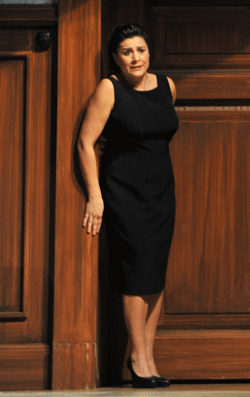 Cecilia Bartoli as Desdemona
Cecilia Bartoli as Desdemona
As Desdemona, Cecilia Bartoli remains at the top of her game. This was my first live experience with La Bartoli in a dramatic role, and well, to frame the experience in a highly complicated, technical way: she sang the living snot out of it. There seemed nothing Cecilia couldn’t do. Her throbbing soprano summoned forth a gutsy fury one moment, and the next could spin out a pianissississimo so achingly delicate we scarce could breathe. The impeccable vocal fireworks we have come to expect were securely on display to be sure, but this night there was less aspiration on the runs and roulades with no loss of color or accuracy. Her unflinching, fierce commitment and her consummate musical imagination were always in evidence, constantly imbued with an unforced, innate musicality.
Since Signora B had considered every dramatic variant possible in the role, she took us on a richly complicated dramatic journey. Along the way, our Diva gave us a searing finish to Act II as she held the penultimate high note with pointed conviction and incredible duration. A short while later, her Willow Song was a master’s class in meticulously crafted, tonally limp, beautifully judged pathos. Our star has made a happy marriage indeed between her medium-sized voice and this jewel of a medium sized house. She performs staged opera most often here, and her public clearly adores her. And why not? With her immensely satisfying catalogue of recordings, her highly personal performing style, and her glamorous persona, there is no international star bigger than Cecilia Bartoli, and damn’ few her equal.
She was splendidly matched with her Otello, John Osborn. He had paired very ably with her in 2010’s Clari but nothing in that lighter piece showed off his awesome skill set. For Mr. Osborn boasts an usually wide range of tessitura, from the expected ‘very high’ to the unexpected ‘very low indeed.’ The richness, responsiveness and directness of his burnished tenor are a joy; and the precision and meaningfulness of his florid singing are not normally expected from a voice of such generous amplitude. Our Moor took the role by storm (as it were) with a potent, bravura vocal display. Moreover, John and Cecilia worked musical magic together, blending seamlessly as their world class instruments intertwined in the extended duet. (A handful of the tenor’s phrases in middle voice were colored with a slightly grainy cast that recalled James McCracken, a bygone — albeit entirely different — Moor.)
One of the stellar singers on the Zurich house roster, Javier Camarena (Rodrigo) summoned forth a marvelous blend of honeyed tone and technical razzle dazzle. Mr. Camerena’s even, secure, warm lyric tenor brought pleasure all evening, and we got the added bonus of the producers assimilating the final cameo of Lucio into his role, giving this talented performer a final scene to steal. Young Edgardo Rocha has grown enormously since I heard him last November in Wexford. His tenor rang out with élan, and his gleaming, bright sound was all the more effective for its confounding our concept of the usual dark voice types we imagine for Iago. Mr. Rocha’s singing was bright, lean and mean, and effectively insinuating. He and Javier conspired to ravish us with a zinger of a duet that fairly crackled with intensity, and reveled in pyrotechnic coloratura displays.
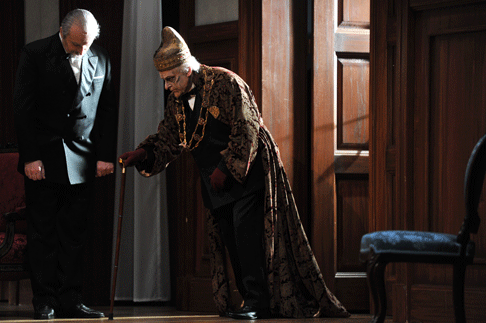 Peter Kálmán as Elmiro and Nicola Pamio as the Doge
Peter Kálmán as Elmiro and Nicola Pamio as the Doge
In the smaller role of Emilia, Liliana Nikiteanu was a beautiful vocal presence. Her somewhat cooler, reasoned, haunting mezzo provided a good balance, and the two ladies manufactured a seamless blend on the plaintive duets. Peter Kálmán showed off an ample, searing bass as an authoritarian Elmiro, sounding as imposing as many a Don Carlo Filippo. Nicola Pamio created a visually senile and doddering, though vocally solid, Doge. Young Artist Ilker Arcayürek’s lovely off-stage tenor brought a mellifluous serenity to the Gondolier’s arietta, so lovely it made us wish for more.
These outstanding soloists were matched in excellence note for note from the pit, populated by the nonpareil ensemble “Orchestra La Scintilla” of the Zurich Opera. Of course, such Early Music evenings begin as they must. They tuned and tuned. And tuned. And then tuned. But then this period instrument band tore into this infrequently heard opus as though it were a masterpiece deserving of their finest efforts. Conductor Muhai Tang was a revelation as he elicited unstinting, dramatically informed playing from his instrumentalists. Maestro Tang brought to bear notably fine pacing and exquisite attention to color and detail. He accommodated the soloists effectively, breathing with them, urging them on one minute, indulging them in elastic phrasing the next. The reading was driving yet highly responsive, a consummately controlled performance. While the entire band was magnificent, there was standout partnering from the solo horn (Glen Borling) and clarinet (Robert Pickup) who assumed real personalities as they helped underline the psychological state of the singers.
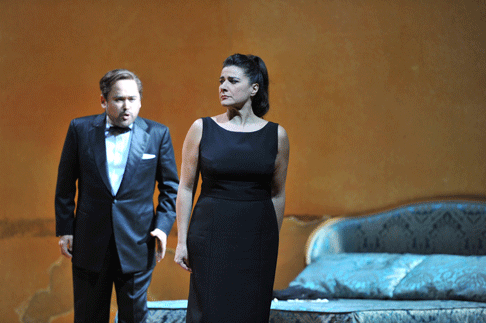 Javier Camarena as Rodrigo and Cecilia Bartoli as Desdemona
Javier Camarena as Rodrigo and Cecilia Bartoli as Desdemona
No less engaging was the well-considered physical production (set design by Christian Fenouillat). At opening, Otello was being celebrated at a formal indoor ceremony in a huge, late 19th century drawing room, cool blue with oversize oak doors. Up stage left, very tall double doors open (and close) to a formal dining room where the guests retire after the opening chorus. A huge white Murano glass chandelier dominates the room, the only other furnishings a deep blue damask settee up center, and matching chairs down left. A large window, left, afforded wonderful lighting effects from designers Hans-Rudolf Kunz and Christophe Forey. The duo suffused the room with a warm orangey sunlight which later morphed to a harsher cross-lighting that made the ominous faces of the lined up chorus visually ‘pop’.
Agostino Cavalca’s clean, modern day costumes also serve the concept well, the chorus in suits and formal wear, Otello in dress blues (later in military work clothes like Iago’s), the Doge in religious drag. Ms. Bartoli looked fetching in a simple black cocktail dress, to which fitted lace sleeves and a pearl necklace were added to good effect. Emilia appeared to be a social secretary, business casual in slacks and a draping gray silk knit top. Desdemona sheds the dress, to end the night in a satiny white slip. Simple. Effective. Each costume told us who the character was.
Desdemona’s bedroom was a vibrant burnt orange, furnished only with a double bed up left and a settee just inside the door stage right, both again blue damask. The other setting was the servants’ cantina, with violently green colored walls, mismatched furniture, a pool table with chairs upended upon it, and two large cold metal doors up right that open onto the street. Within these re-imagined locales, directors Moshe Leiser and Patrice Caurier crafted a persuasive case not only for their vision, but also for Rossini’s drama.
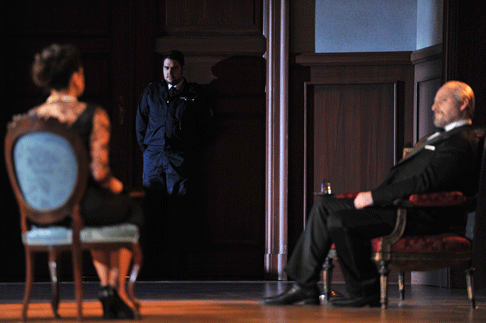 Cecilia Bartoli as Desdemona, Edgardo Rocha as Iago and Peter Kálmán as Elmiro
Cecilia Bartoli as Desdemona, Edgardo Rocha as Iago and Peter Kálmán as Elmiro
They accomplished this with unfussy, fluid blocking that placed singers in advantageous stage positions to be able to be seen and heard. (It sounds simple but you have no idea how often that is not the case in Euro-Concept productions.) Next, they kept their singers tightly focused on each other, exploring the dramatic truth that was the underpinning for the need to sing their emotions in the first place. Next, they knew when to get their performers into an effective picture and then stay relatively still, allowing them to sing complicated ensembles (like the fiendishly difficult sextet) to maximum effect. And finally, they contrived just enough unique business to inject a bit of edginess into the proceedings. A few examples:
The thinly disguised racism of the court is pointed up by having a pair of servants appear at the dining room doors with trays of food. The white server is allowed in with his tray, the black server is relieved of his and turned back to the kitchen. When he reappears with a coffee service, it is knocked out of his hands as Elmiro storms through the doors from the dinner. His seething look withers the poor servant into an apologetic mopping up of the mess.
In Two, Otello is presented hanging out drinking beer in the servants’ recreation area, underlining his social status. At that act’s end, as Elmiro discredits his daughter, Desdemona, barefoot now (trapped down left between the pool table, the refrigerator, and the Deep Blue Sea) deliberately and oh-so-slowly reaches into the fridge and pulls out…a beer with which she sarcastically toasts her father. She plays the scene a bit unhinged which works sensationally well, climaxing with a crawl up to stand on the pool table. As she towers over dad, screaming the afore-mentioned searing high note at him, she dementedly pours the beer all over herself. Nuts. Brilliant. Meaningful. They all scramble to grab her down to stop her making a display of the family business in front of the servants.
In the final act, a resplendent treatment of the Willow Song began with Desdemona hauling out an old phonograph from under her bad. She knelt and placed it downstage in silence, lifted and set the needle, and the tune began to play through the speakers. Julie Palloc’s wonderful recorded harp-playing was a little LP-scratchy at first, but as the live orchestra snuck in when Bartoli began singing, we had experienced a luminous effect indeed. The final visual coup: after Otello had stabbed Desdemona and she lay bloodied and lifeless against the back wall, the stage right wall (with locked door) tracked toward center creating a split stage. On the outside were the (now) forgiving, conciliatory forces, while in the bedroom our trapped hero careened helplessly, unlocking the door and stabbing himself just as the optimistic court flooded in. As Elmiro and Rodrigo came upon Desdemona’s corpse, they found an outlet for their shock and grief by kicking the Moor’s crumpled body, reminding us of the racism that had, after all, started the plot’s inexorable descent into tragedy.
To sum up: If this thrilling evening in the opera house was not theatrical and musical perfection, well, then I don’t know what is.
James Sohre
image=http://www.operatoday.com/Otello_Zurich_01.gif image_description=John Osborn as Otello [Photo by Hans Jörg Michel courtesy of Opernhaus Zürich] product=yes product_title=Gioachino Rossini: Otello product_by=Otello: John Osborn; Desdemona: Cecilia Bartoli; Elmiro: Peter Kálmán; Rodrigo: Javier Camarena; Iago: Edgardo Rocha; Emilia: Liliana Nikiteanu; Lucio: Javier Camarena; Doge: Nicola Pamio; Gondolier: Ilker Arcayürek; Conductor: Muhai Tang; Director: Moshe Leiser, Patrice Caurier; Set Design: Christian Fenouillat; Costume Design: Agostino Cavalca; Lighting Design: Hans-Rudolf Kunz, Christophe Forey; Chorus Master: Jürg Hämmerli. product_id=Above: John Osborn as OtelloPhotos by Hans Jörg Michel courtesy of Opernhaus Zürich
March 4, 2012
Mazeppa in Monte-Carlo
If Mr. Stein was preoccupied with the larger political implications of this ignoble moment of Russian history, metteur en scène Dieter Kaegi in this co-production with Opera Ireland dwells on the sordid personalities of its protagonists. Peter Stein’s Ukraine was its expanse, in Dublin and now Monaco the Ukraine became a small drawing room where a treacherous general seduces a gullible adolescent whose simple father naively tries to wreck revenge.
Peter Stein’s cast could not have descended to this basic humanity had it wanted to, but Mr. Kaegi’s cast was indeed able and maybe a bit too willing. Bass-now-baritone Tómas Tómasson made a handsome, just-graying Mazeppa whose intrinsic masculinity could not help but awaken the sensibilities of the gullible young Maria, the lithesome Tatiana Pavlovskaia.
The parents of Maria are quite comfortable, bass Paata Burchuladze was the very picture of bourgeois contentment together with mezzo Elena Manistina as his wife. Both are quite comfortable artists with fine, well used rich voices, and unobtrusive stage mannerisms. Maria’s intended, the plain, uncharismatic Andreï was Dmitro Popov who compensated with quite ample vocal charisma.
You get the idea, a great cast, all nurtured in Russian vocalism and style (though Mr. Tomasson is in fact Icelandic). Add Russian conductor Dmitri Jurowski for a clean sweep. Mo. Jurowski is perhaps a new breed of Russian conductor, all business, little pleasure in the smaller musical gestures that color Tchaikovsky’s more personal moments. The battle scenes roared, the confrontations howled, and finally Maria’s madness was relentlessly driven by the obliging Orchestre Philharmonique de Monte-Carlo. The only thing lacking was poetry.
Mr. Kaegi (general director of Opera Ireland) together with designer Rudy Sabounghi and costumer David Belugou (both frequent contributors to Monte-Carlo productions) updated the action from Peter the Great’s reign to the 1930’s or so, a transposition it did not wear well. But never mind, the wigs, costumes and room furnishings were visually engaging (handsome and colorful indeed), and provided absolutely no sense of rural Ukraine in what must have been a fairly austere period (the 1930’s).
Unfortunately the supertitles, maybe faithful to Tchaikovsky’s text, often belied the staging, making a gap in the credibility of either. Like, for one example, the festive picnic at the execution of Maria’s father and the massive hammer and sickle banner that oversaw the scene. Orlik, Mazeppa’s thug aptly portrayed by Opera Ireland bass Gerard O’Conner, motivated his mutilation of Maria’s father by first shaving himself in the prison cell — evidently he just happened to have a straight razor that could have other uses.
This reduction of Mazeppa to a melodrama with all the trappings of a 1940‘s movie might have worked with a tighter theatrical technique. As it was the inconsistency of the staging with the libretto and the heavy handed use of staging leitmotifs prevented an effective realization of the concept. Mr. Tomasson’s over-acting and Mlle. Pavlovskaia’s mannered presence added a touch of soap opera caricature to production.
It was a festive evening in Monte-Carlo, the performance well appreciated by an international audience, the automotive artillery guarding the entrance to the opera house cum casino included an orange Koenigsegg CCX and a splendid vintage Mercedes Benz roadster.
Michael Milenski
image=http://www.operatoday.com/mazeppa.png
image_description=Mazeppa [Monte Carlo]
product=yes
product_title=Pyotr Ilyich Tchaikovsky: Mazeppa
product_by=Mazeppa: Tómas Tómasson; Maria: Tatiana Pavlovskaia; Kotchoubeï: Paata Burchuladze; Lioubov: Elena Manistina; Andreï: Dmitro Popov; Orlik: Gerard O’Conner; Iskra Vadim Zaplechni; Drunken Cosaque: Laurent Chauvineau. Salle Garnier. Choeur de l’Opera de Monte-Carlo. Orchestre Philharmonique de Monte-Carlo. Conductor: Dmitri Jurowski. Metteur en scène: Dieter Kaegi. Scenery: Rudy Sabounghi. Costumer: David Belugou. Lights: Laurent Castaingt. (24 February 2012)
product_id=
Previn conducts the LSO in the 1970s
Apparently Rachmaninov became one of Previn’s conducting specialties in his time with the LSO, and a BBC telecast of a 1973 proms telecast preserved a performance of the composer’s rarely performed The Bells, a work for orchestra, soloists and chorus based on an Edgar Allen Poe poem.
Available again on DVD from ICA Classics, this performance may look dated, with its slightly faded color and the wide lapels and long hair on so many of the male musicians. The sound is sharp and clear, however, and Previn leads a dynamic, detailed reading. His fine soloists, obviously comfortable with the English libretto, are Sheila Armstrong, Robert Tear and John Shirley-Quirk. Anyone with a bias against British singers who might have what is called a “plumy” tone, emphasized by fussy enunciation, will be pleased by these singers commitment to the work and concentrated vocal production. Rachmaninov’s melodic invention did not transfer over very well into the works for voice he wrote, but The Bells has passages of great beauty. Think of this as a fine opportunity to enjoy a relative rarity, even though there may be no particular reason to re-watch the actual concert performance more than once. Unless one has an inexplicable nostalgia for shaggy locks and wide lapels on men…
ICA offers two other pieces from separate BBC filmed concerts, a colorful jaunt through Prokofiev’s Lieutenat Kijé suite and a rip-roaring race through Bernstein’s Candide overture. Previn projects confidence and elegance from the podium, although with his pageboy haircut and oversized glasses he looks a bit like Edith Head in tuxedo drag.
Other than the usual credits and a nice essay by the aptly named David Nice, the booklet basically serves as advertisement for other ICA concert performances on DVD. No bonus features.
Chris Mullins
image=http://www.operatoday.com/ICAD-5038_CMYK_0_0.png
image_description=ICAD 5038
product=yes
product_title=Sergei Rachmaninoff: The Bells; Sergei Prokofiev: Lieutenant Kijé; Leonard Bernstein: Candide — Overture
product_by=Sheila Armstrong, soprano; Robert Tear, tenor; John Shirley-Quirk, bass-baritone. London Symphony Chorus & Orchestra. Conductor: André Previn.
product_id=ICA ICAD 5038 [DVD]
price=$24.99
product_url=http://www.arkivmusic.com/classical/album.jsp?album_id=612237&album_group=2
March 1, 2012
A Midsummer Night’s Dream, GSMD
Instead of the usual cramped GSMD theatre, this took place in the Barbican Theatre, which allows much more scope for ambitious work, and training in theatre skills, part of the GSMD brief. At the Barbican, young artists of the future have a bigger platform in every way.
A magical effect to begin with. The mechanical curtain was imaginatively clothed in sparkling metal strips. Then, the set revealed a dormitory, perhaps some spartan public school whose fees don’t cover humane accommodation for the inmates. Fair enough, for Britten was traumatized at boarding school, and his music retraces lost innocence over and over again. Then in come the lovers, Demetrius, Lysander, Hermia and Helena appear in 1940’s military garb. Later, Bottom awakes in a bed suspended above the stage. If these images seem familiar, they’re derived. like collage, from several recent professional productions including the ENO, Garsington Opera and Glyndebourne. That’s not in itself a problem, since GSMD students are there to learn.
Perhaps this production was a collaborative effort, involving as many students as possible in the process, but Director Martin Lloyd-Evans might have exerted tighter editorial control to ensure a coherent vision. There are many levels in Shakespeare and in Britten, so A Midsummer Night’s Dream provides wonderful opportunities for young directors and designers to engage with many ideas. This time, though, everyone seemed to be playing safe. The designs (Dick Bird) don’t suggest that much thought has been put into the production. GSMD students are capable of very good work indeed. Read here about their production of Dialogues des Carmélites last year That was outstanding, and would have done credit to a professional house.
When the energy of the cast is engaged, however, there are excellent moments. The mechanicals, in particular, moved precisely, as if in a chorus line, each man perfectly synchronised, arms askew. (Movement by Victoria Newlyn). Very impressive, but individual personalities are not well defined. Not even Bottom, whom Shakespeare singles out for special treatment. It’s a wonderful role, which Barnaby Rea sang well but wasn’t called upon to develop theatrically. The lovers were well done, Ashley Riches’s distinctive voice instantly recognizable, even in anonymous uniform. We need good countertenors and Tom Verney’s Oberon had imposing presence. He’s very young so could well develop an interesting profile. Good singing from the choruses, particularly the quartet of fairies, who were vivacious and well blocked. Given the high calibre of GSMD’s Technical Theatre course participants, one might have expected more imaginative special effects to create the magic the staging lacked. At the Linbury Theatre a few years ago, Puck was played by a circus artist, abseiling from wires, as if he could fly.
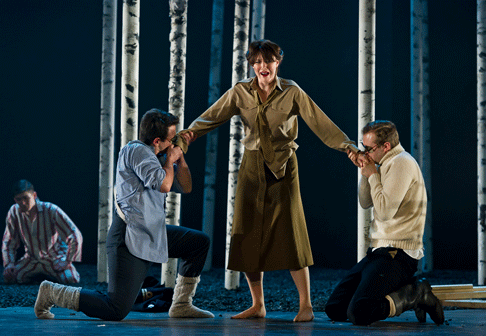 Sky Ingram as Helena, Stuart Laing as Lysander and Ashley Riches as Demetrius
Sky Ingram as Helena, Stuart Laing as Lysander and Ashley Riches as Demetrius
Nonetheless, best for last. Shakespeare and Britten wrote the Mechanical’s stage play with such wit that it’s impossible not to make it effective theatre. Now each singer made his mark, each evidently enjoying himself camping up and having fun. Theseus, Hippolyta and the lovers sneer, but Shakespeare and Britten knew that amateur dramatics have quaint charm.
Anne Ozorio
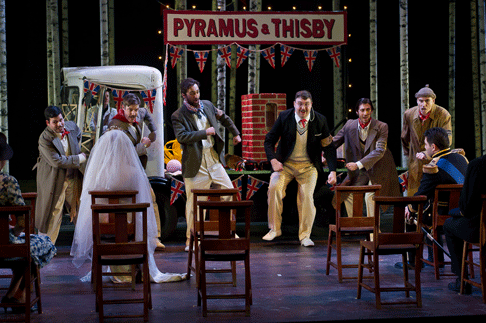 The Mechanicals
The Mechanicals
Photos by Clive Barda courtesy of Guildhall School of Music and Drama
Giuseppe Verdi: Aida
This video is based on the HD broadcast on 24 October 2009, which was released in this format in late 2011. With a cast including some of the finest performers currently available, this production of Aida merits attention.
At the core of this cast is Dolora Zajick as Amneris, the Egyptian princess at the center of the love triangle that includes Aida and Radames. Zajick makes her character memorable, with the unrequited passion motivating both her acting and, more importantly, the musical qualities. This is evident from the opening scene, with the exchange between Amneris and Radames effective (disc 1, band 5). Yet the scene in Amneris’s chambers in act two (disc 1, bands 13-16) offers a more intensive portrait of the Egyptian princess, which Zajick delivers with élan. Here Violetta Urmana allows the conflicts in her character's situation to emerge, as the love for Radames betrays the loyalty to her homeland, and any disobedience to her mistress Amneris intensifies the risks she faces. As impressive as Urmana is in the first part of the opera, her scena in Act 3 (disc 2, bands 1-6), particularly “O patria mia” (disc 2 band 2), where Aida's dilemma reaches its climax. The intensity that Urmana offers is captured well in this video, with the sound quality reflecting the live performance and acoustics of the Met.
Johan Botha brings his polished tenor voice to the role of Radames, and his opening aria “Celeste Aida” (disc 1, band 4) offers a solid performance of the famous aria. The dynamic and expressive nuances of Botha’s performance merit rehearing in this video, which offers a fine representation of the ringing sound and rounded tone. The range and depth of the voice is even throughout, especially the final duet with Urmana in the tomb scene of Act four (disc 2, bands 11-12). The polished sound and stage experience allow Botha to give the touching music Verdi created for the final scene to emerge convincingly.
Of the other roles, the performance offers solid casting, with Roberto Scandiuzzi as Ramfis, and Stefan Kocán as the king. Kocán has since taken on other roles at the Met and elsewhere, and this video is a rare chance to hear the bass in the early part of what promises to be a fine career. The estimable Carlo Guelphi brings a sense of nobility to the role of Amonasro. The duet with Urmana as Aida in the third act, “Ciel! mio padre” (disc 2, band 3) gives a fine sense of Gulephi’s expressive qualities in this role.
Beyond the overt gestures that Aida requires, the intimacy of the final scene is a strong part of this video. As large as the Met staging is in the other acts, the production serves the score well in creating a milieu for Botha and Urmana to interact in this final duet, “O terra, adio.” As the lovers Aida and Radames face death by being buried alive, Urmana and Botha are both expressively powerful, with each singer bringing out fine tone and touching expression. In the hands of these talented performers Verdi’s vocalism comes to life in this performance. Botha is impressive for his supple tone and impressive delivery, and Urmana performs with the same powerful musicianship. Zajick’s presence is notable for the solace she brings to the stage in praying for Radames as the drama comes to its tragic conclusion.
Along with these principals, the Metropolitan Opera Chorus is outstanding in this production, particularly in the “triumphal scene” of Act 2 (disc 1, bands 17-23). In delivering the spectacle of legendary dimension, the Met makes full use of the stage in this colorful production, which Gianni Quaranta designed, along with costumes by Dada Saligeri. The stage direction of Stephen Pickover makes this familiar set piece attractive, with the splendor attributed to ancient Egypt echoed in the generous staging of the Met.
The aspect of movement is important in this work, with the stage of the matter a fitting canvas for the effective blocking to underscore the drama in the work. With the camera angles set up at various points around the stage, including above it, viewers can enter more deeply into the performance than possible inside the Met. This is useful for the ballet sequences, where dance becomes part of the milieu for this work. In this regard the choreography of Alexei Ratmansky is a strong asset of the production for its creative use of movement to fit the libretto and the production as a whole.
In addition to the visual dimensions of the opera, which this DVD captures well, the sound is notable for its full and resonant sense of the house. With minimal audience sounds, the recording levels captures nuances from the stage that are not always possible to hear in all parts of the house, a dimension that the Met brings effectively the HD transmissions, like the one for this particular broadcast. The extras in this release include Renee Fleming’s interviews with the principals (included at the end of the disc 1), as well as choreographer Ratmansky. As whole, the release preserves a fine recent performance of Verdi’s Aida with impeccable quality. It has much to recommend as it brings this work to audiences beyond New York and the HD transmission in 2009.
James L. Zychowicz
image=http://www.operatoday.com/Decca_001573609.gif image_description=Giuseppe Verdi: Aida product=yes product_title: Giuseppe Verdi: Aida product_by=Roberto Scandiuzzi, Violeta Urmana, Johan Botha, Dolora Zajick, Metropolitan Opera Chorus, Metropolitan Opera Orchestra, Daniele Gatti, conductor. product_id=Decca 001573609 [2DVDs] | 001601559 [Blu-ray] price=$37.99 (DVD) product_url=http://www.arkivmusic.com/classical/album.jsp?album_id=587975